
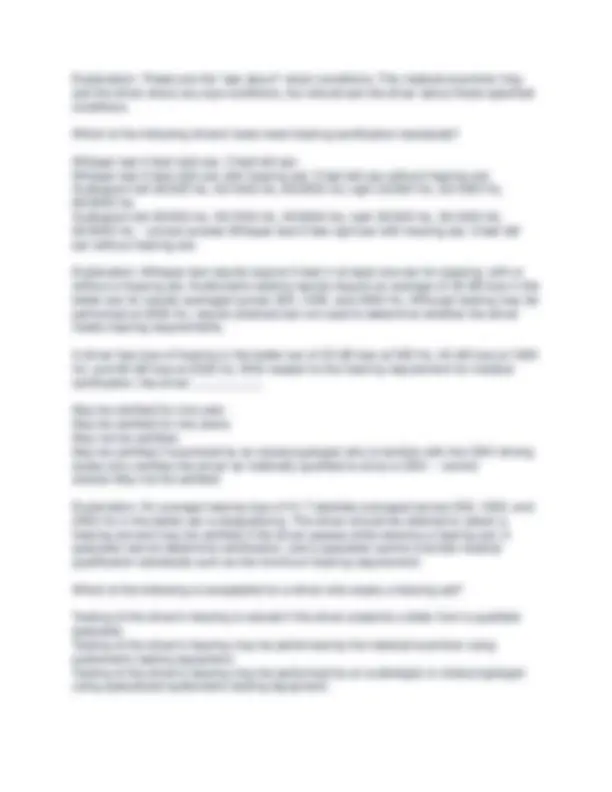
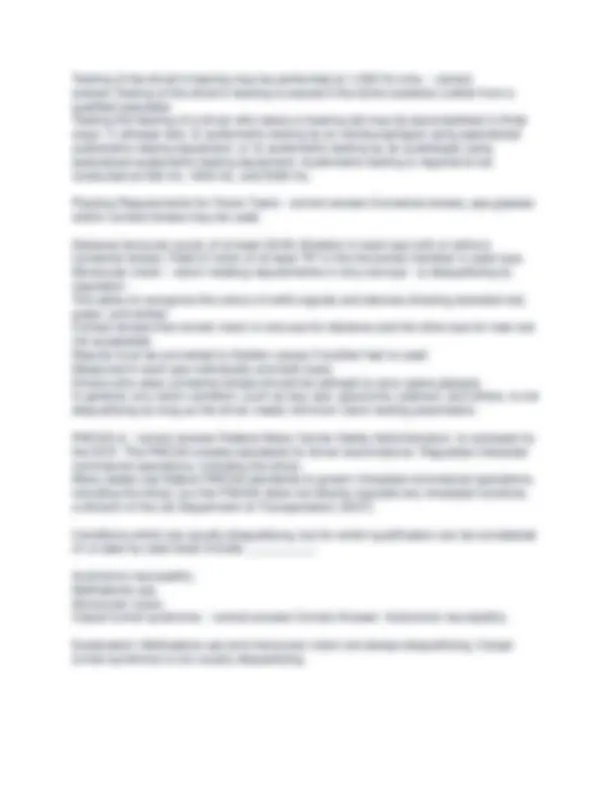
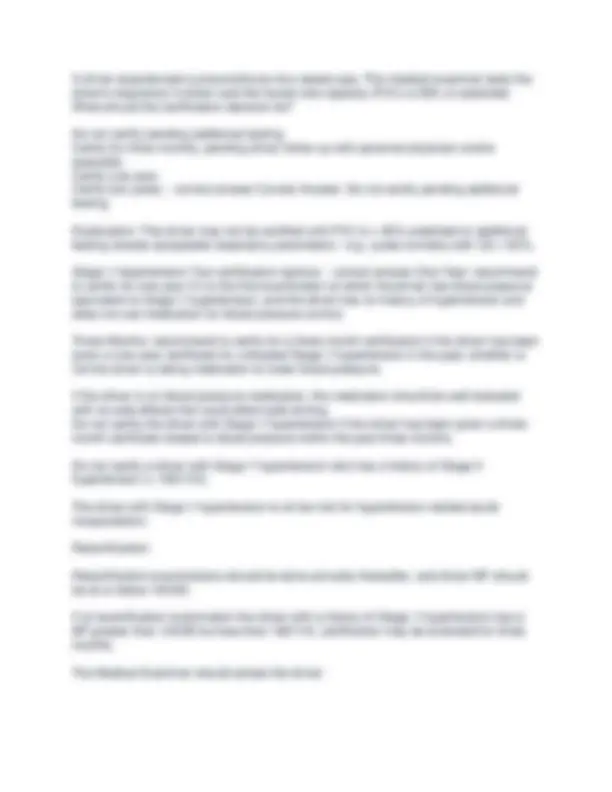
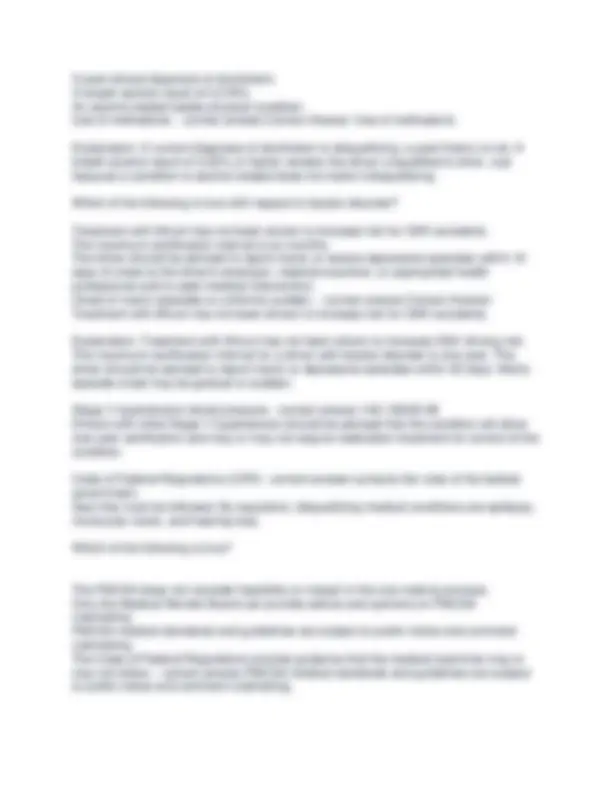
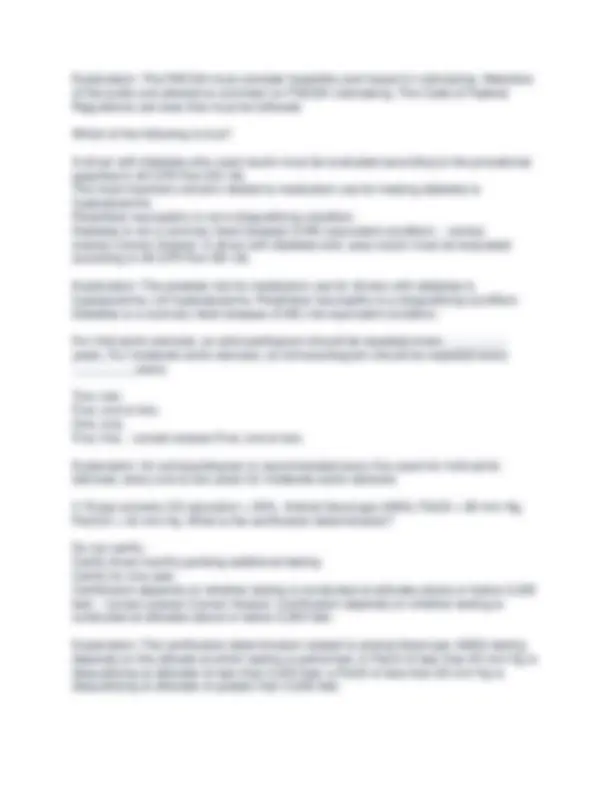
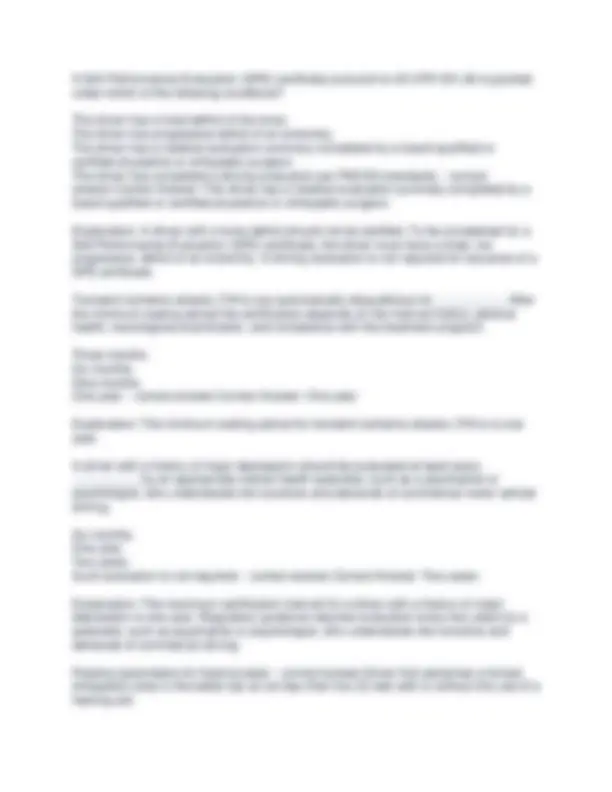
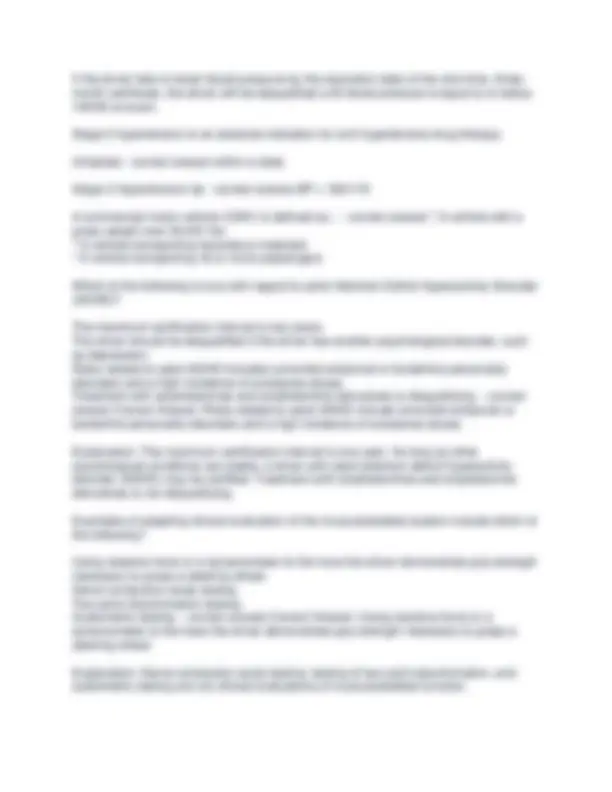
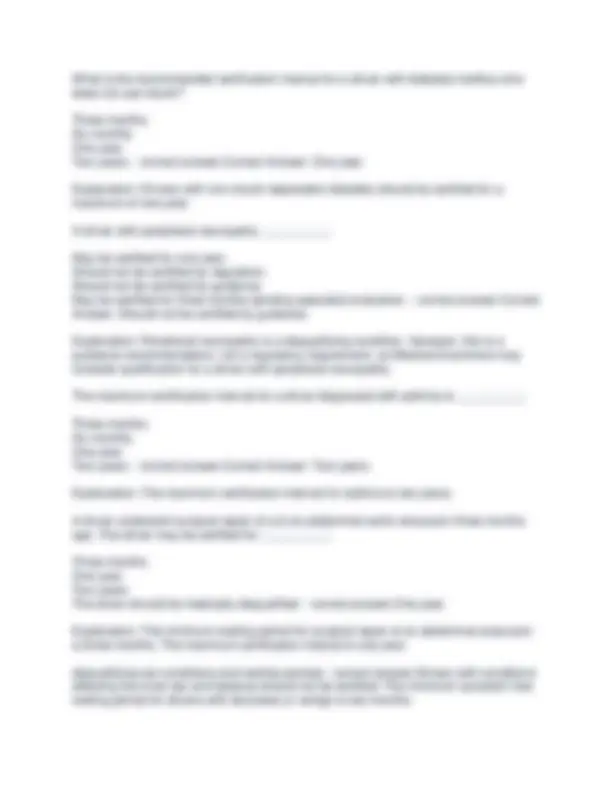
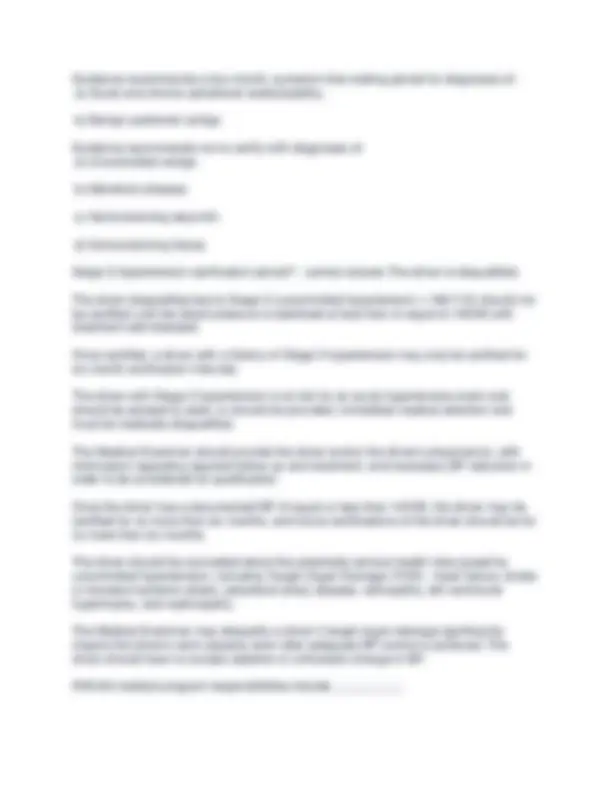
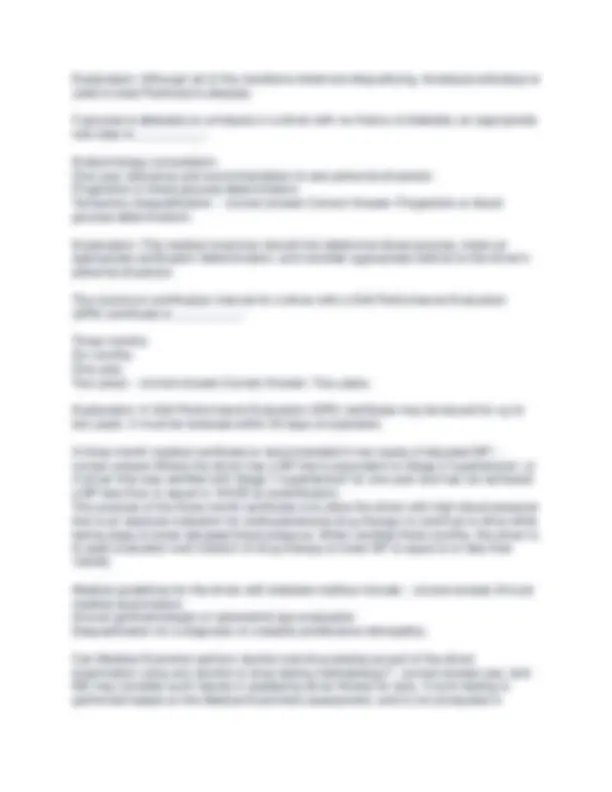
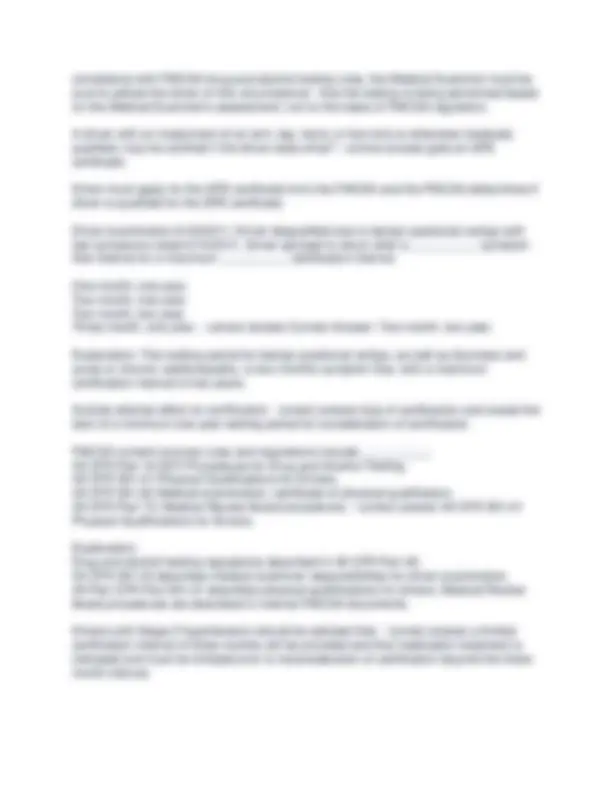
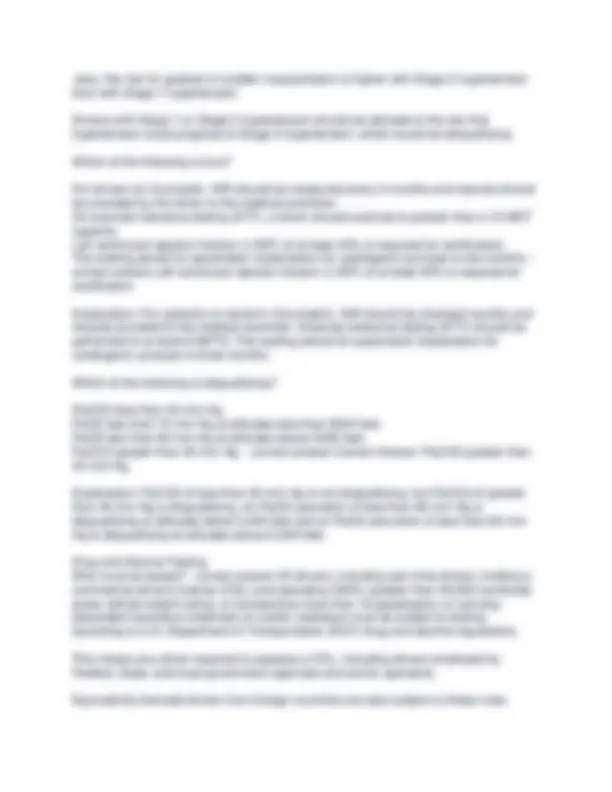
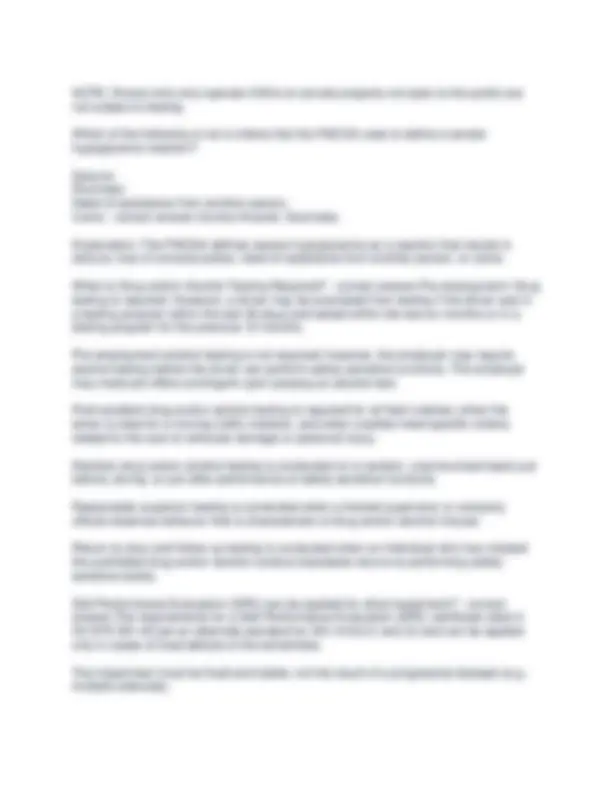
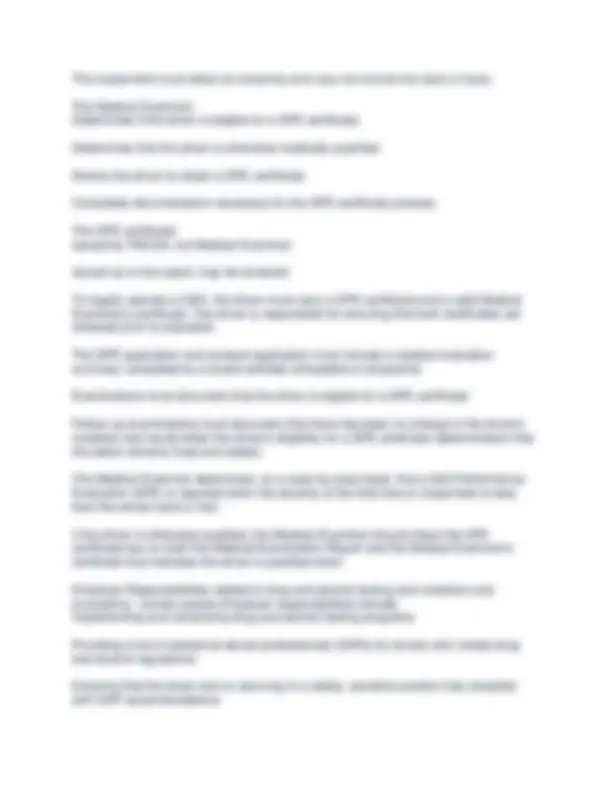
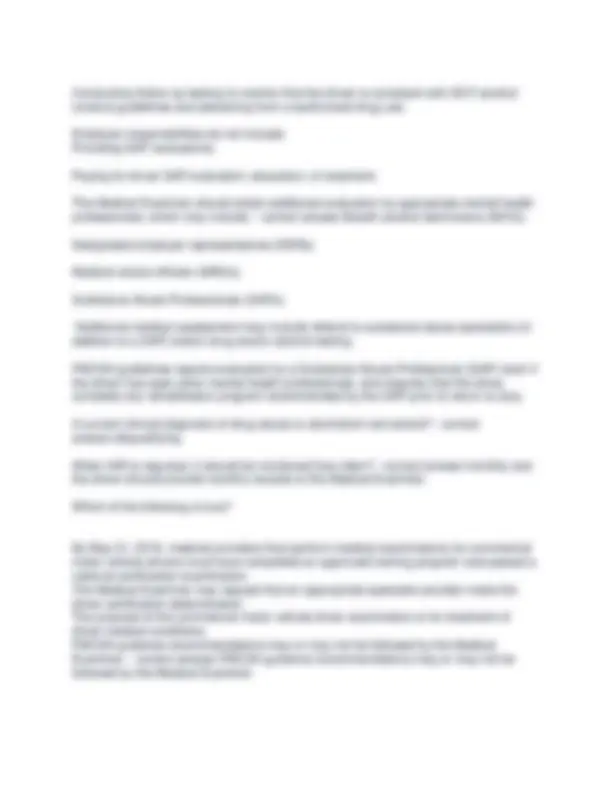
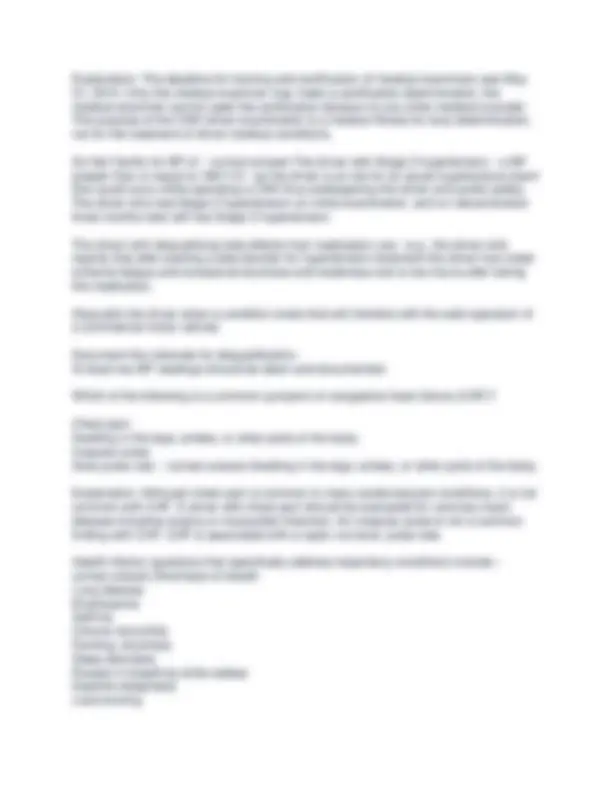
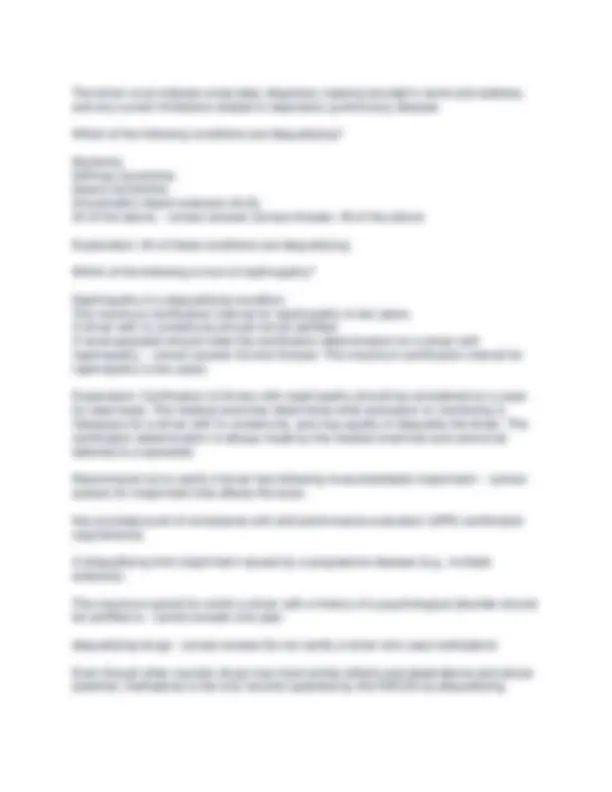
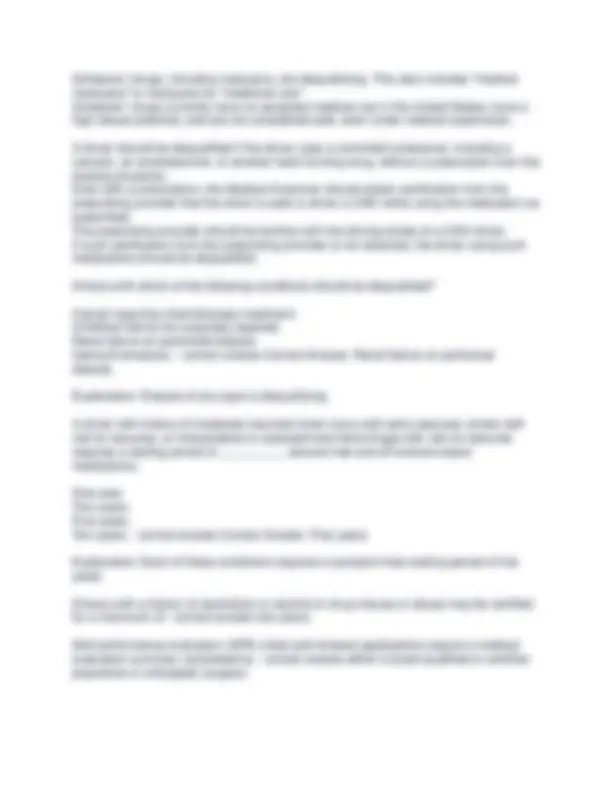
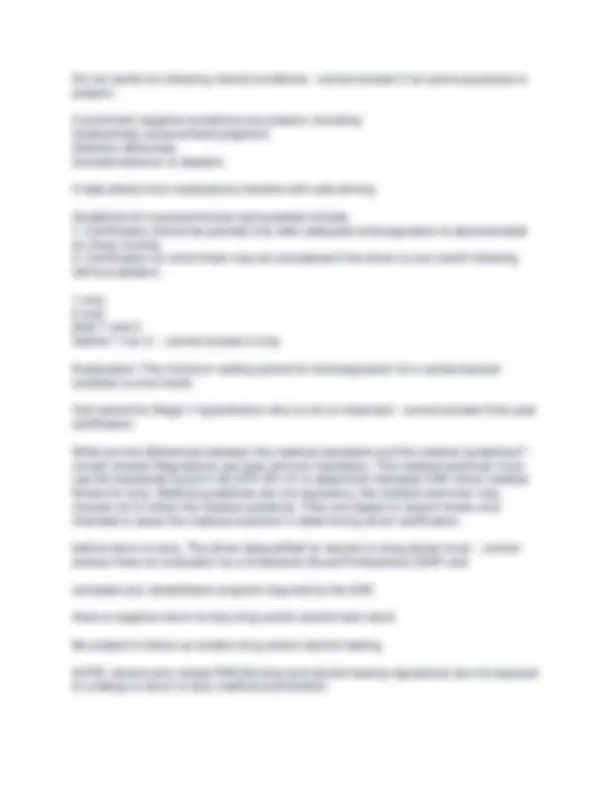
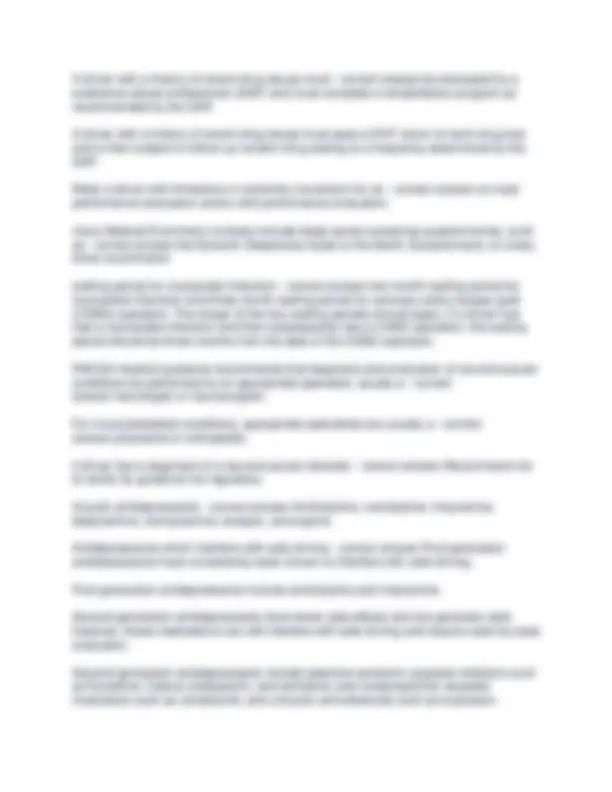
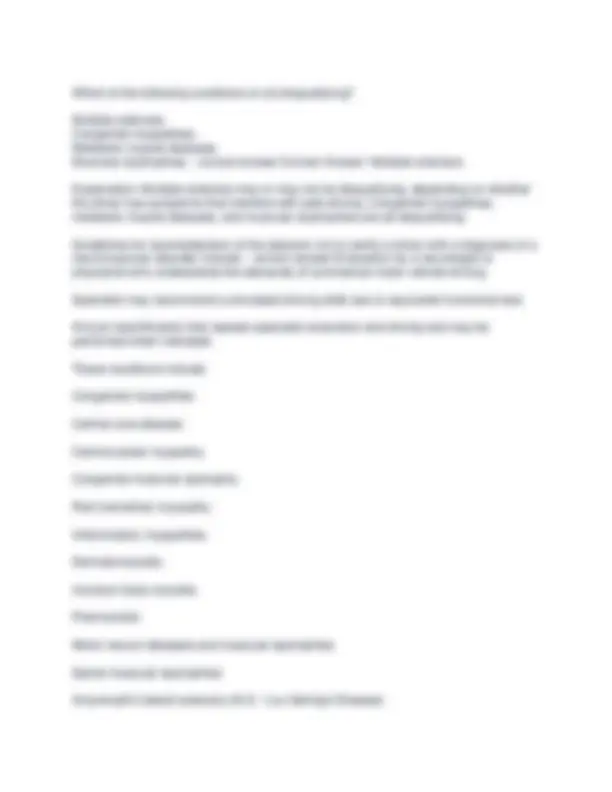
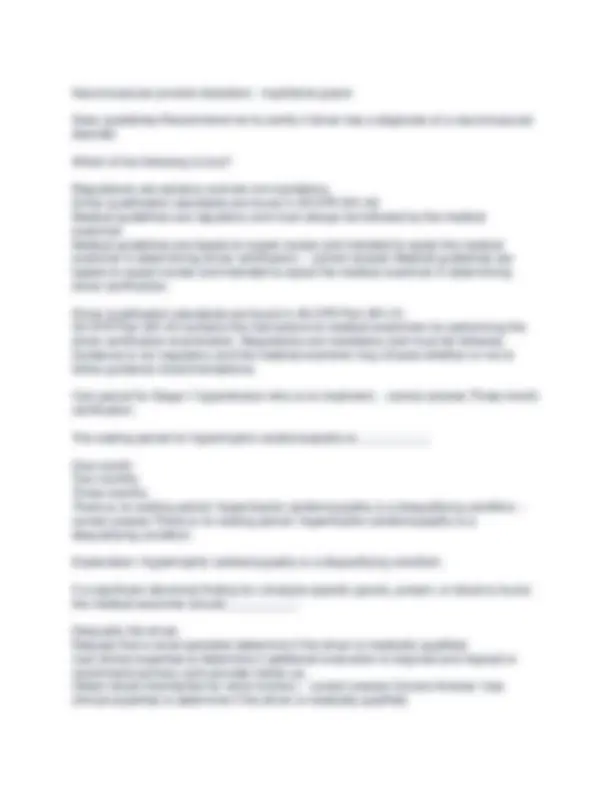
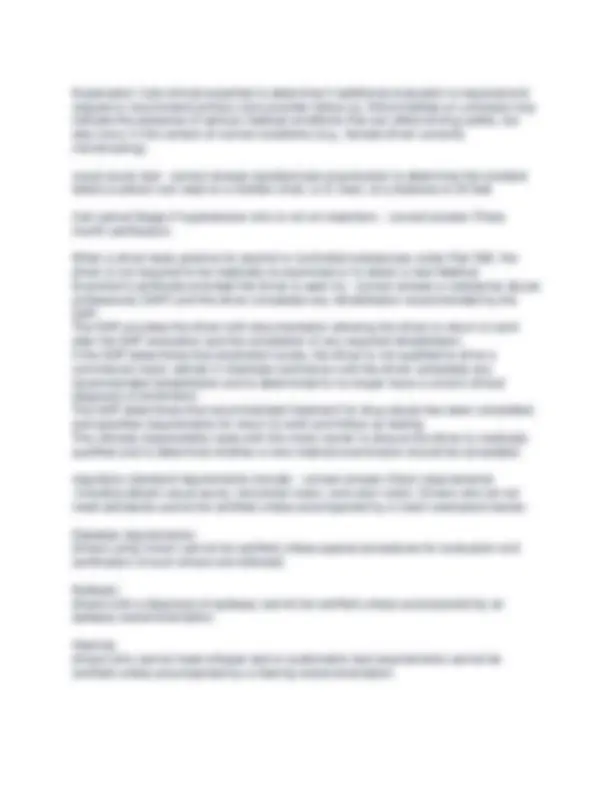
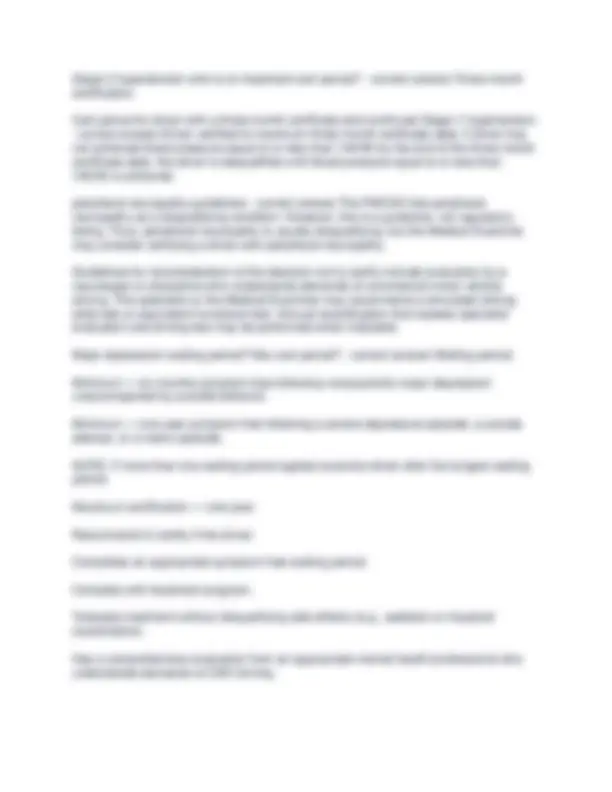
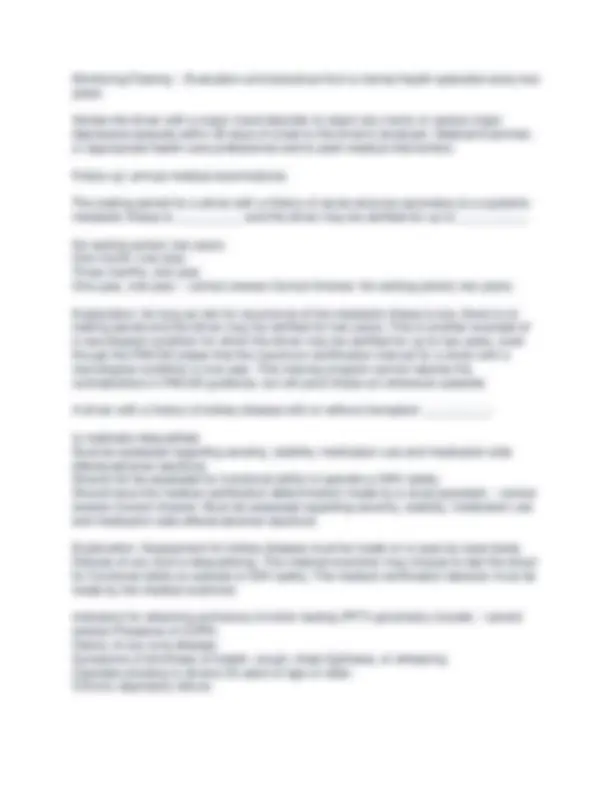
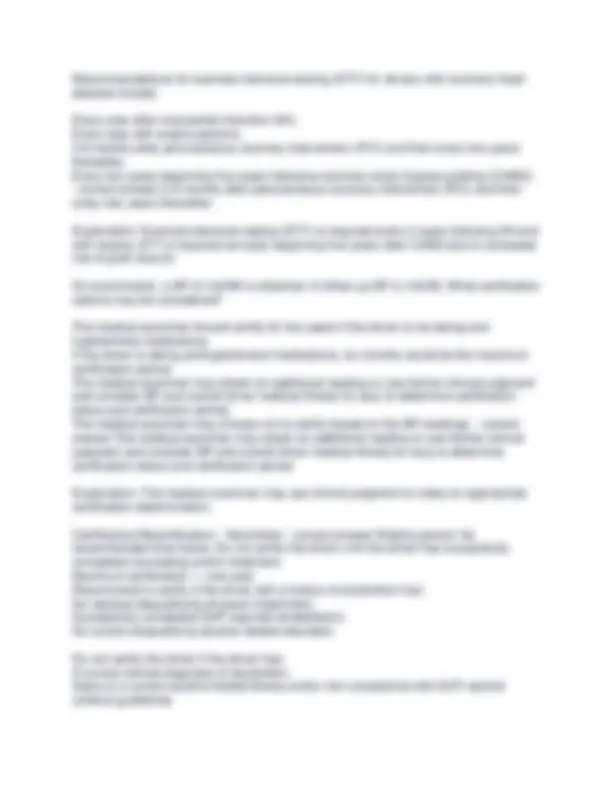
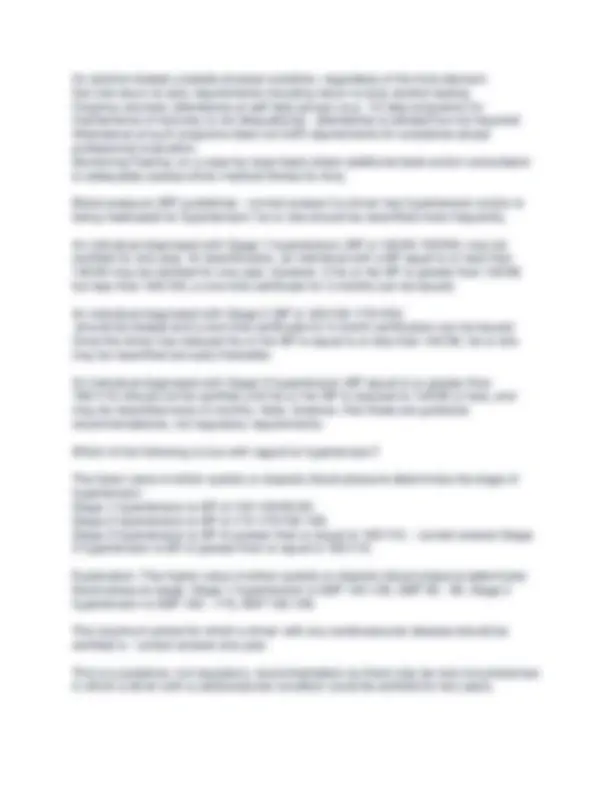

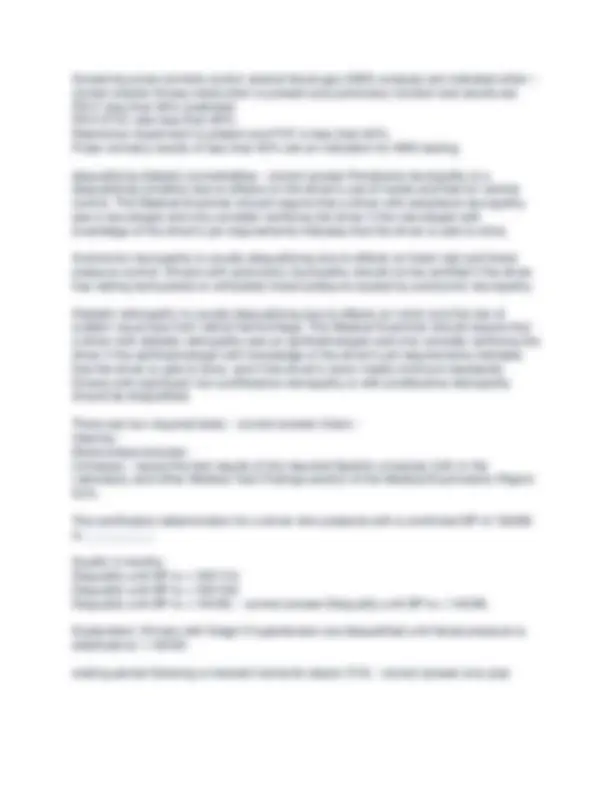
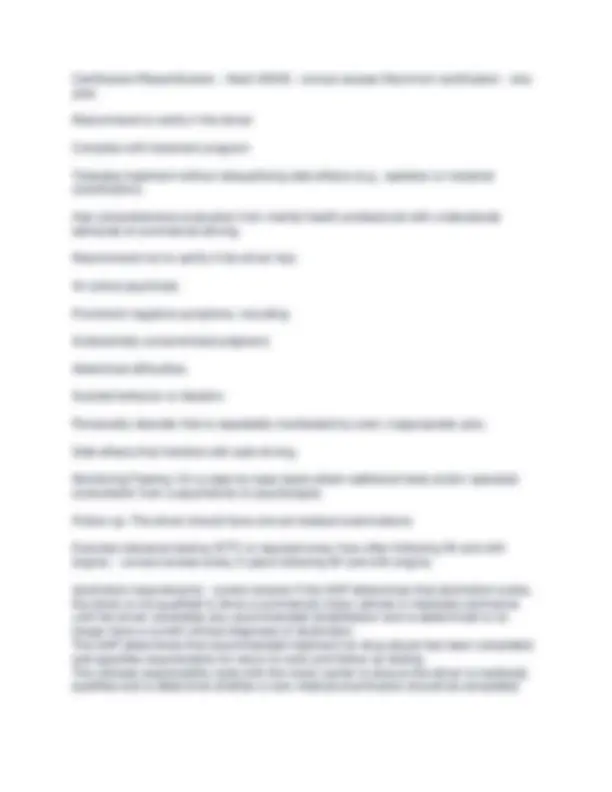
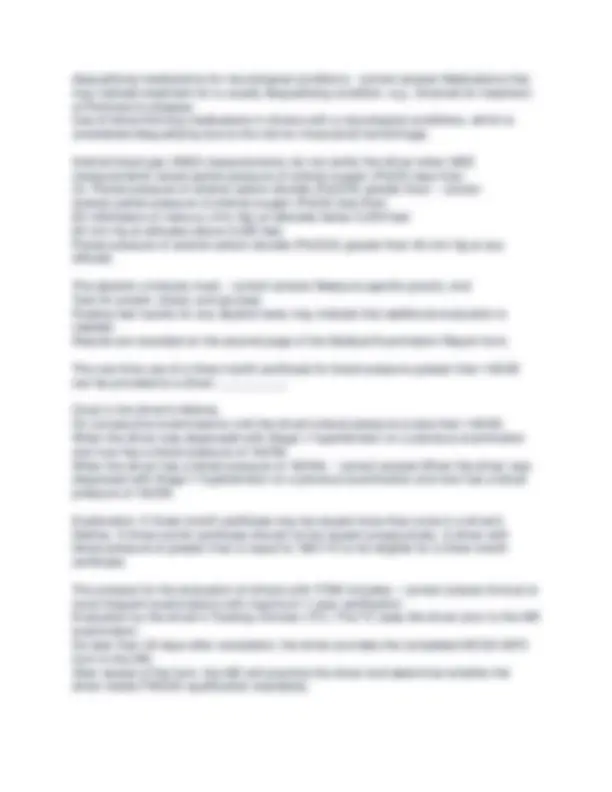
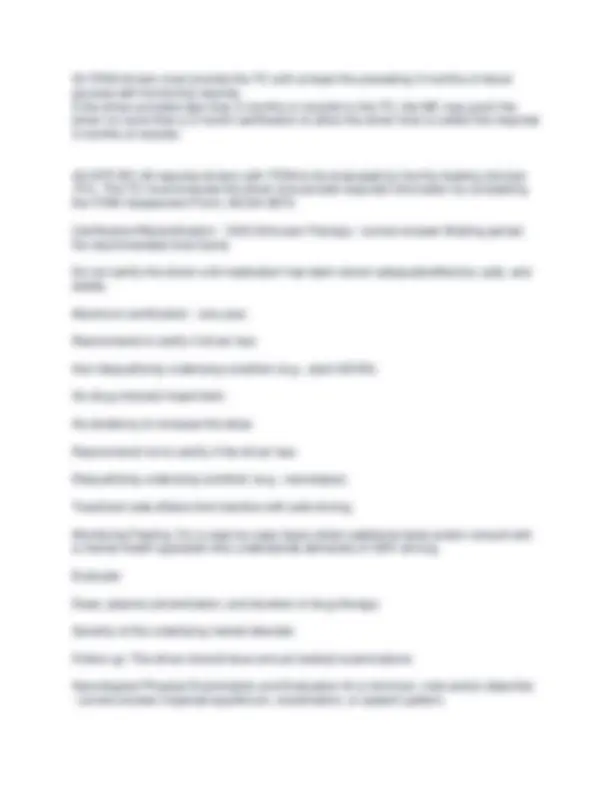
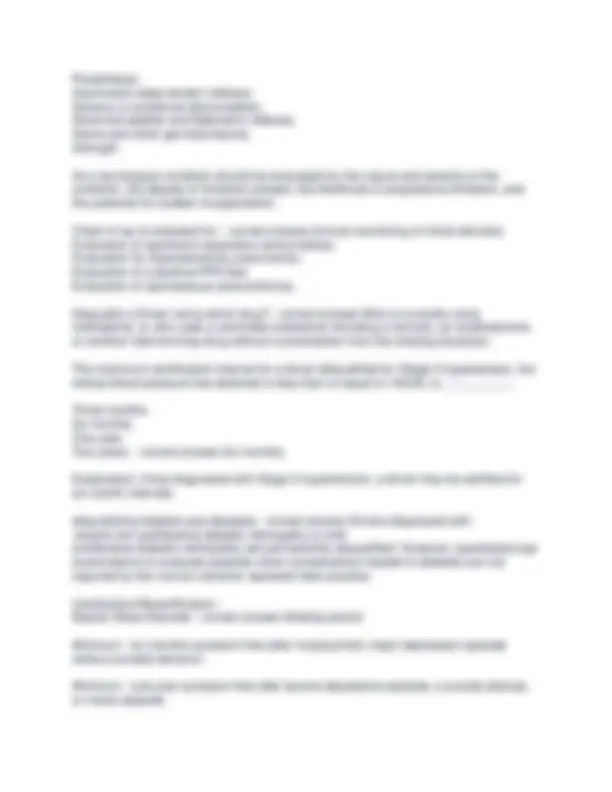

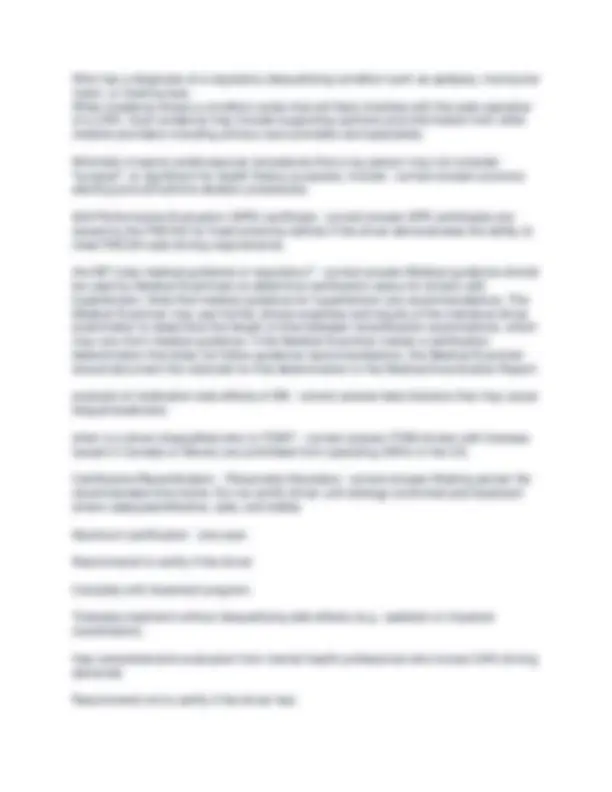
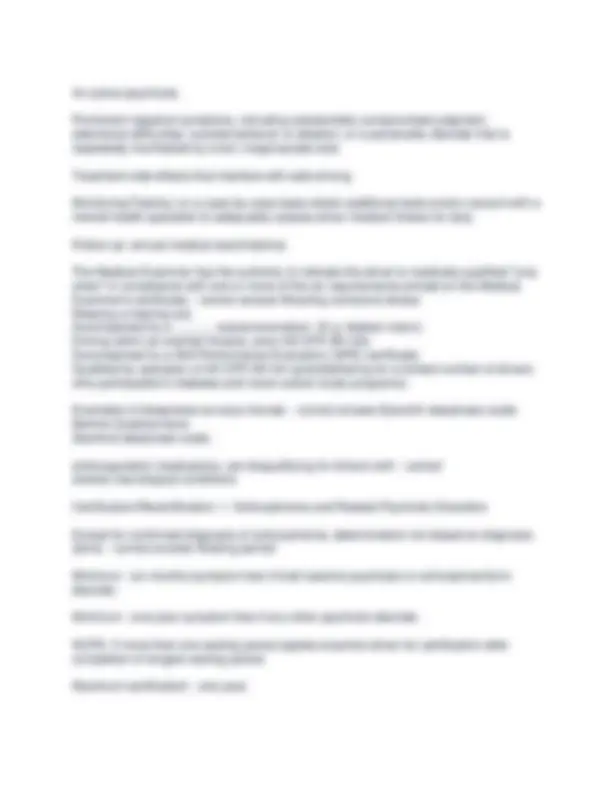
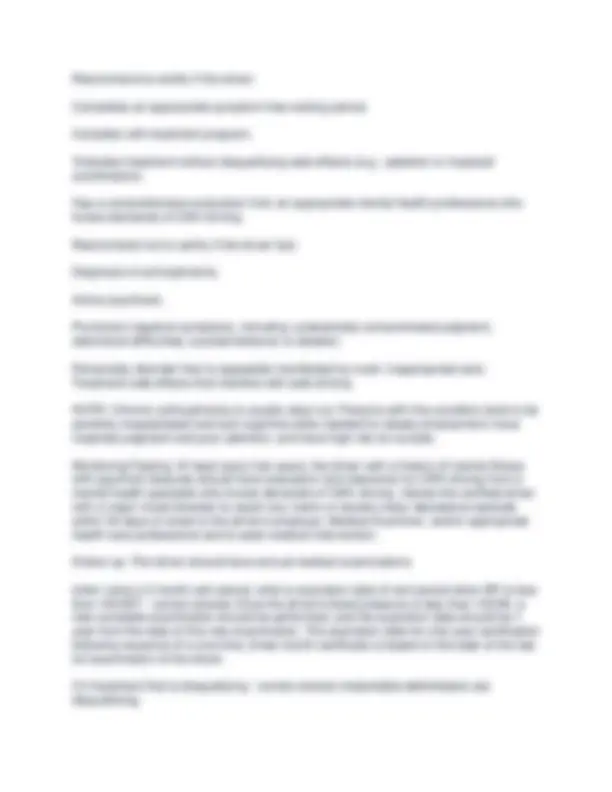
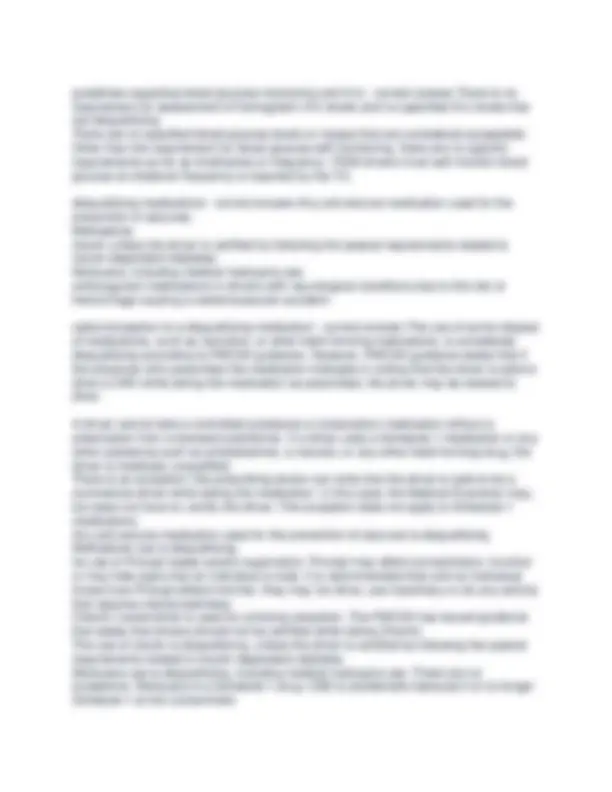
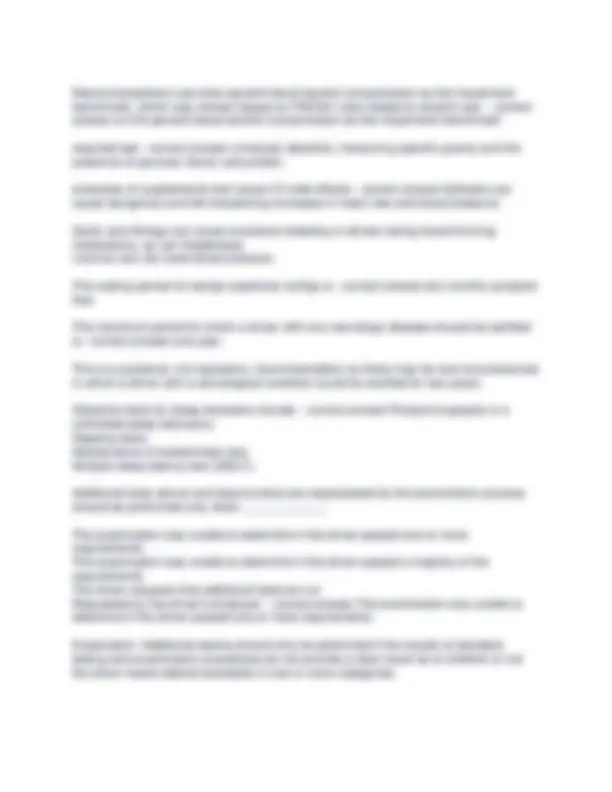
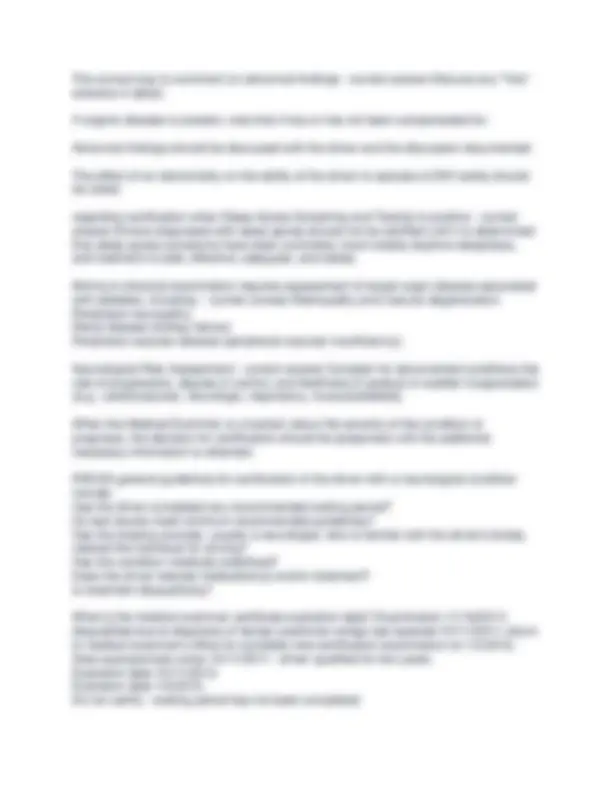
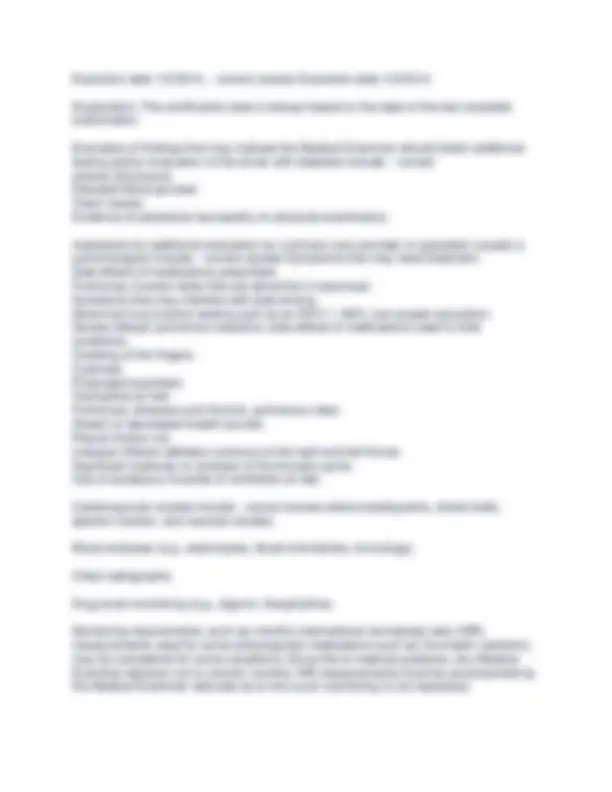
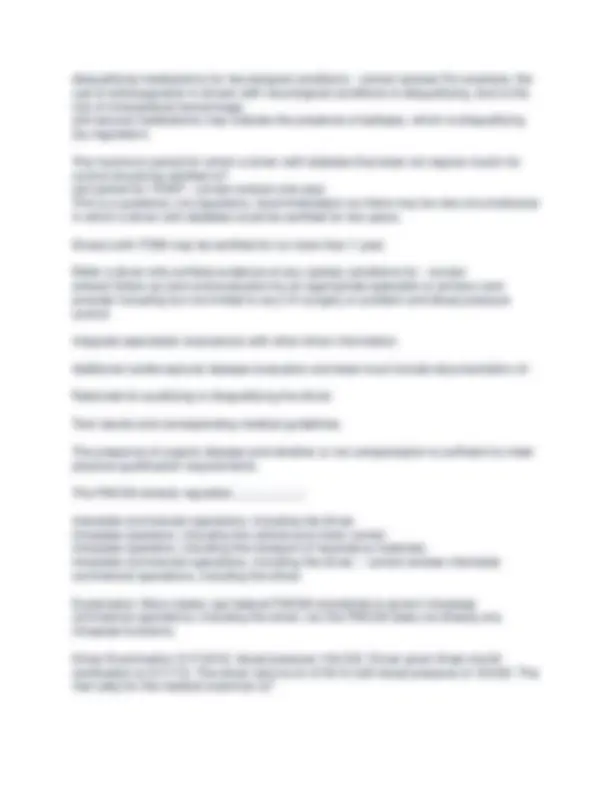
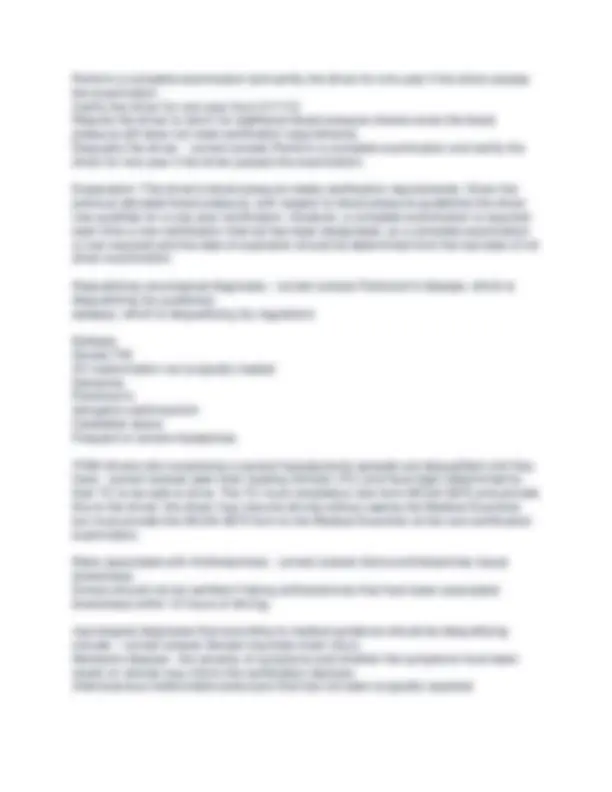
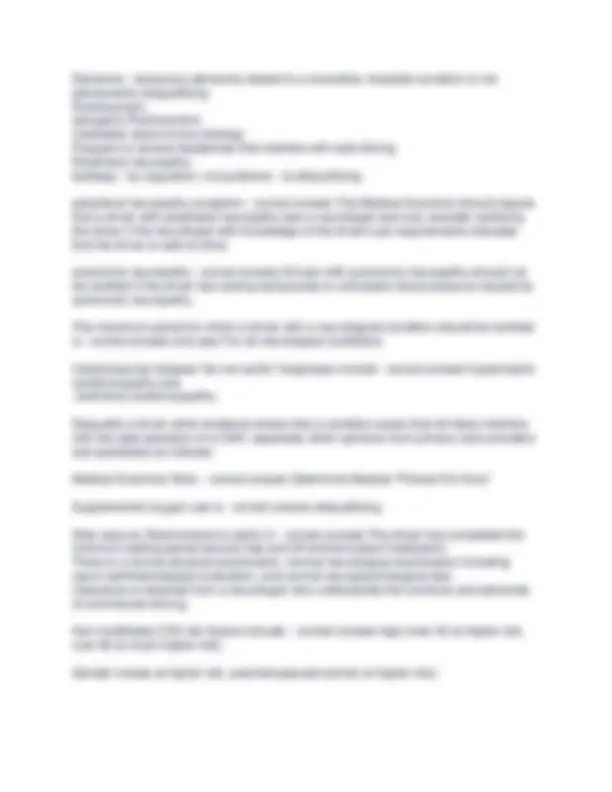
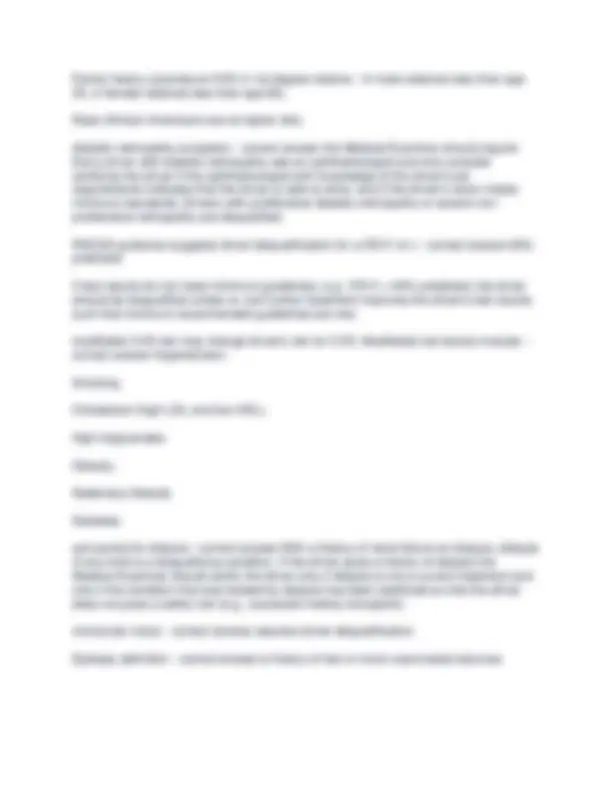
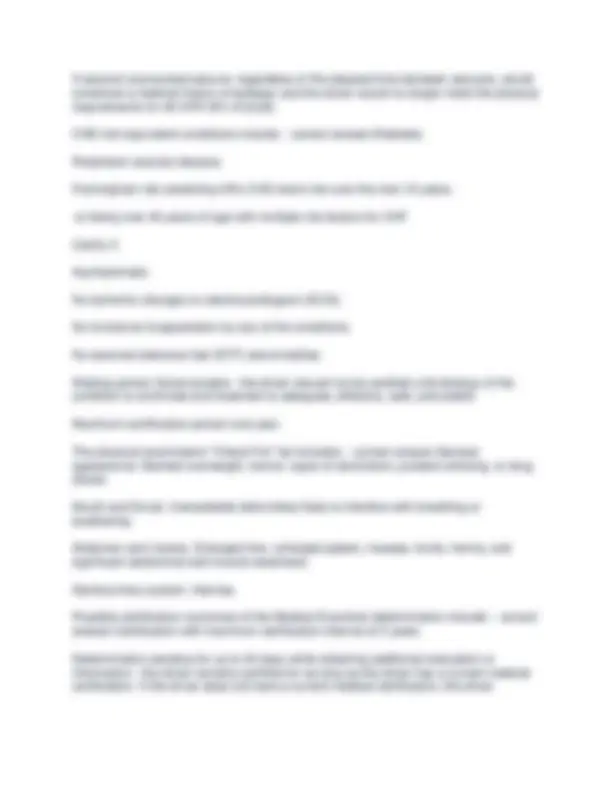
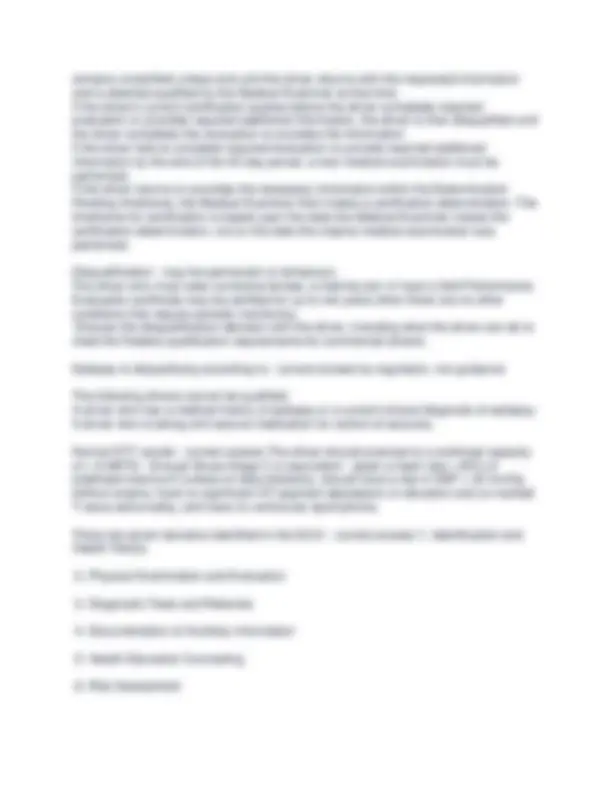
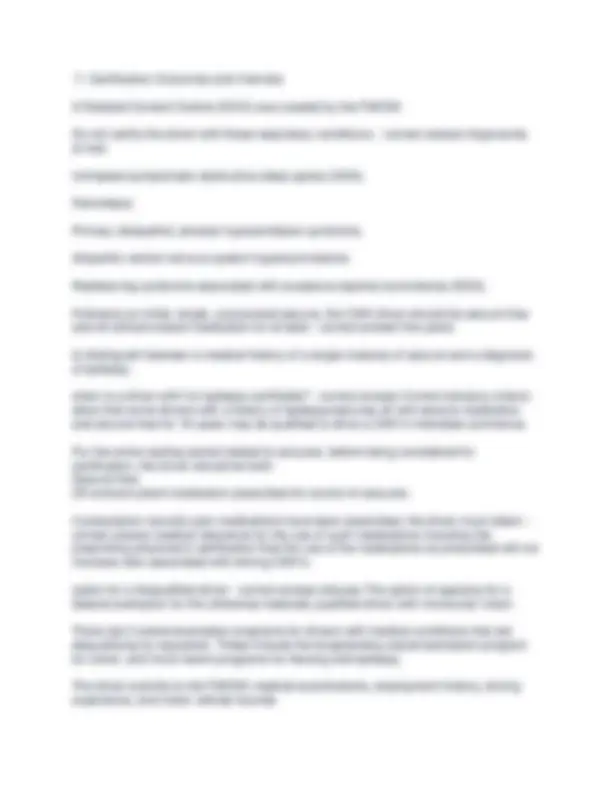
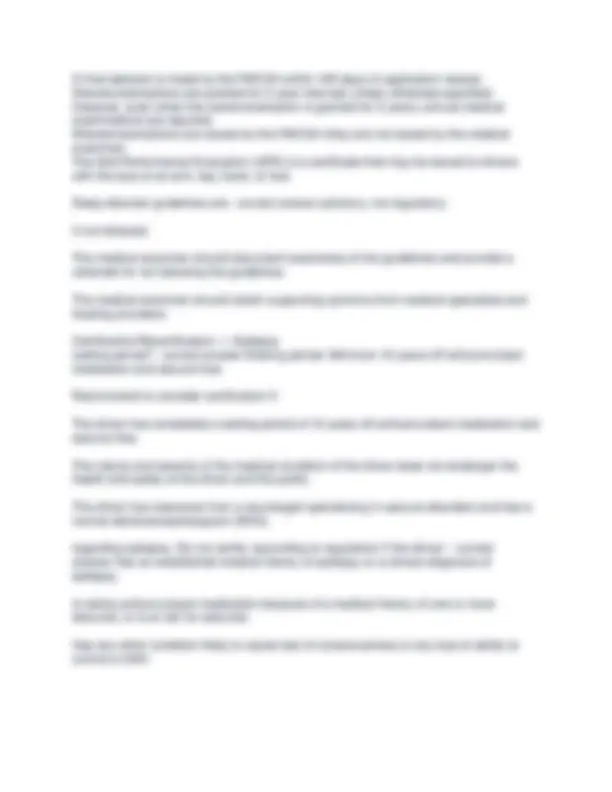
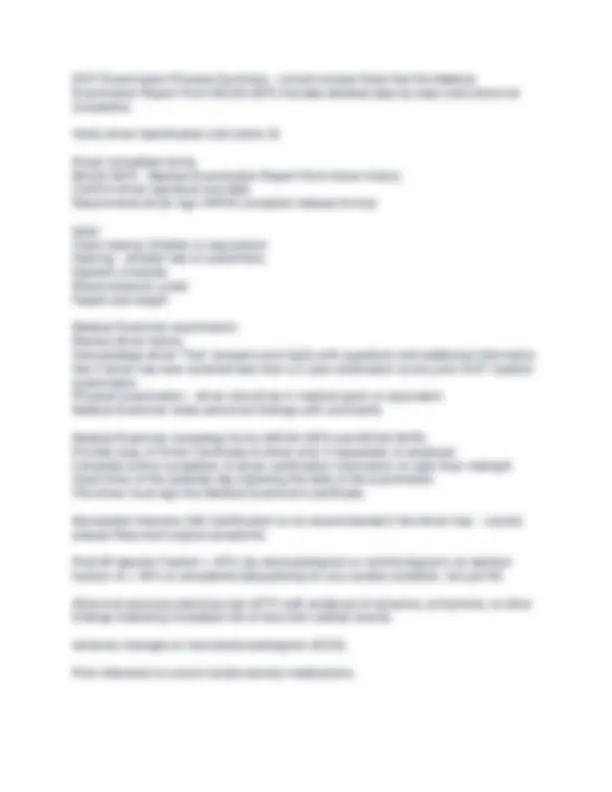
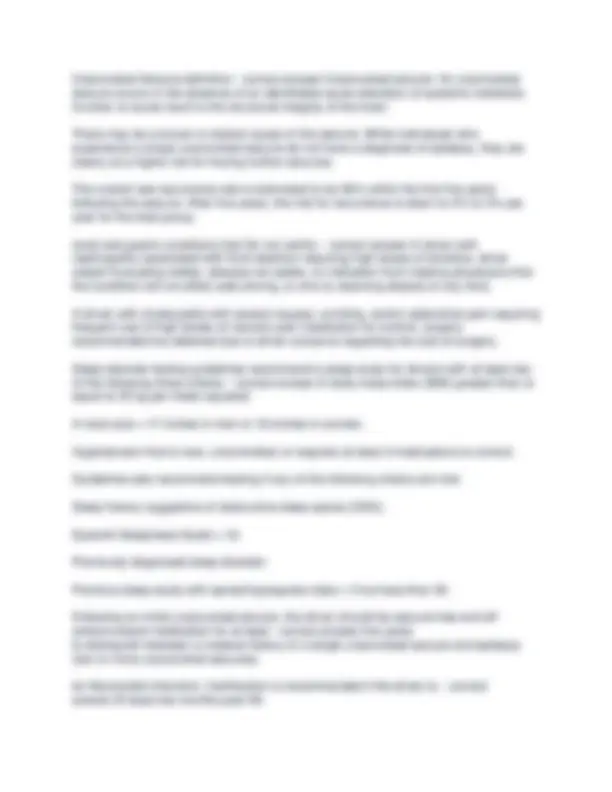
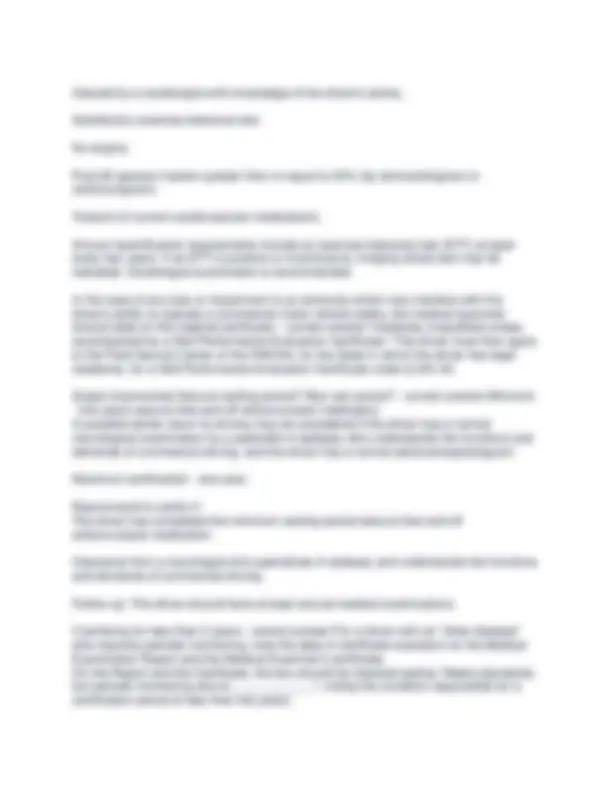
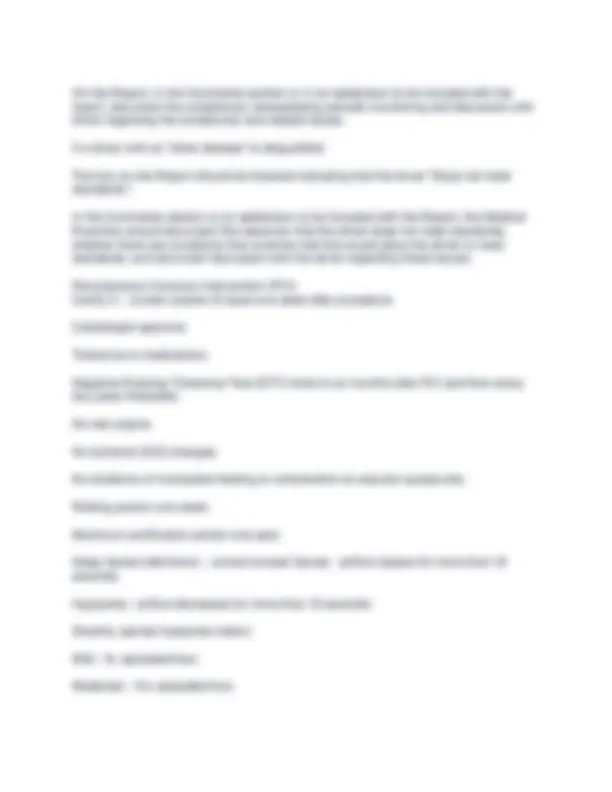
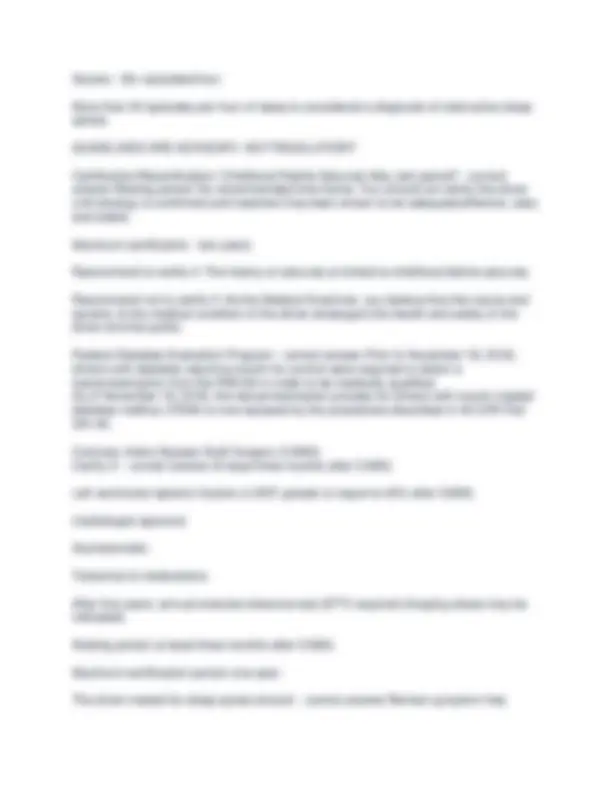
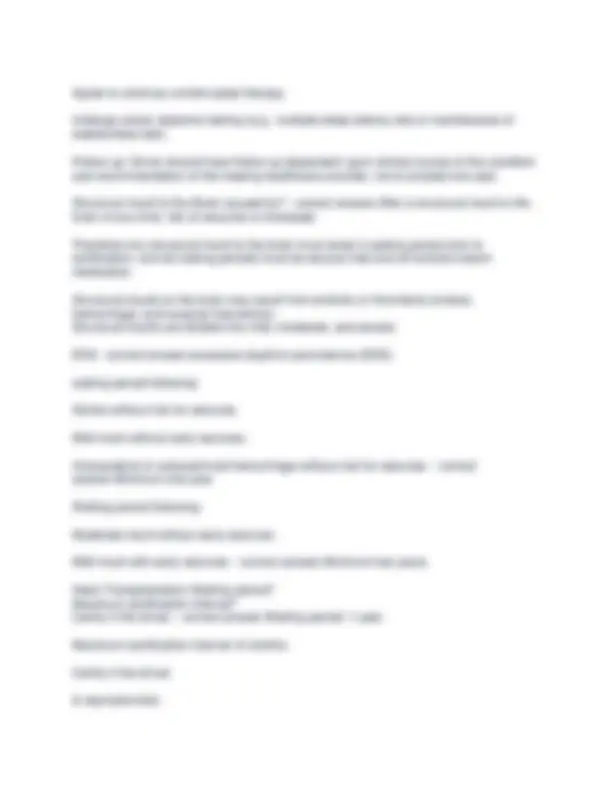
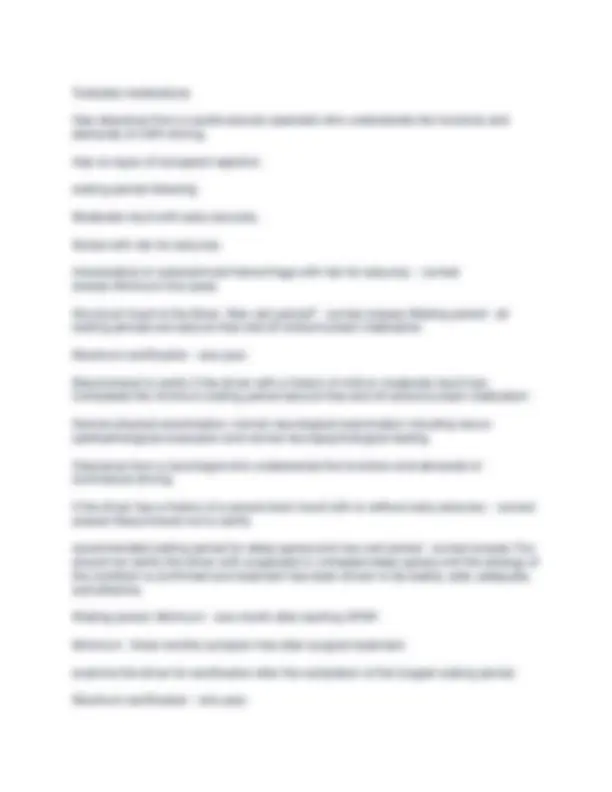
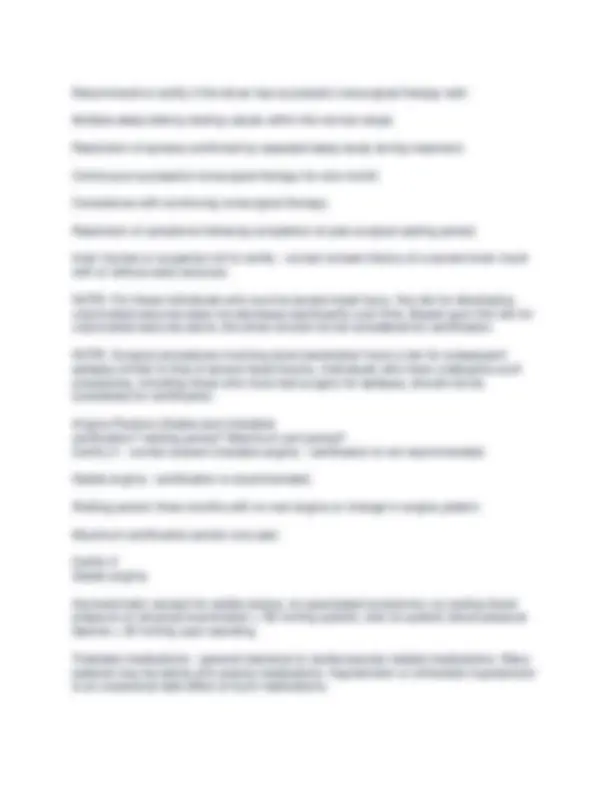
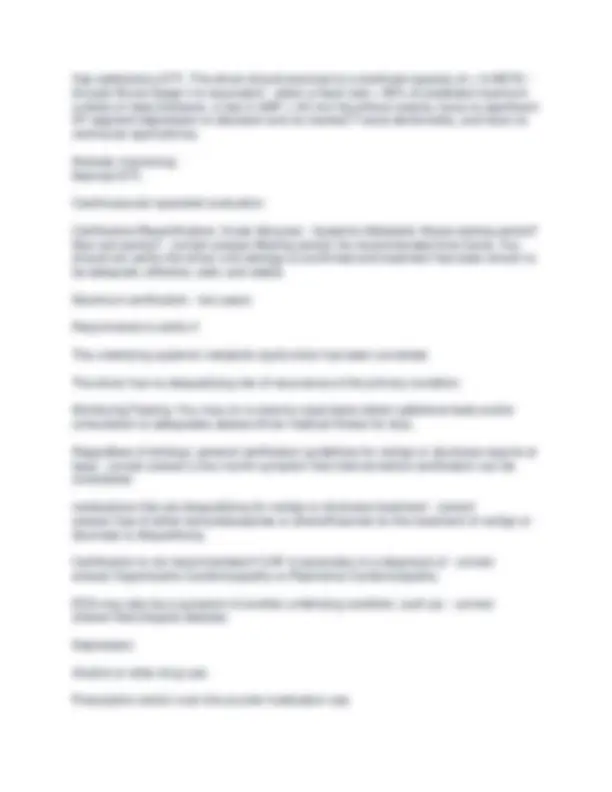
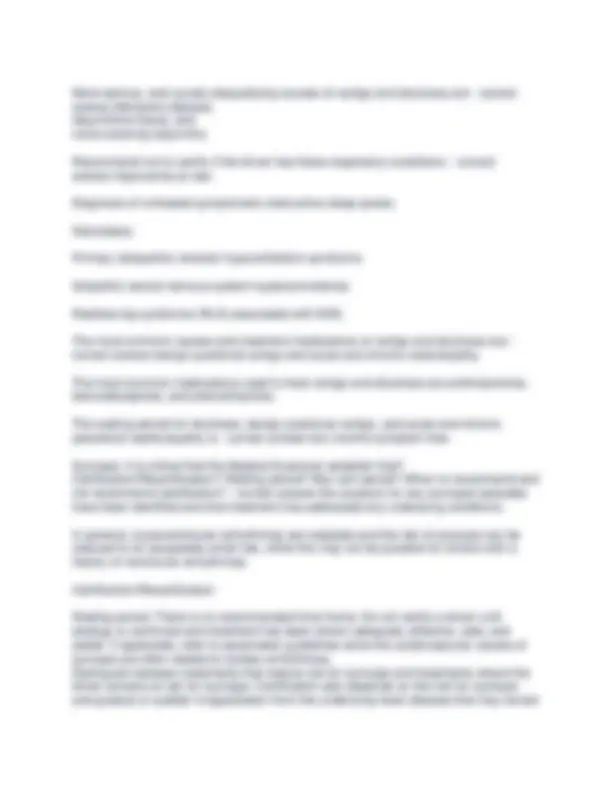
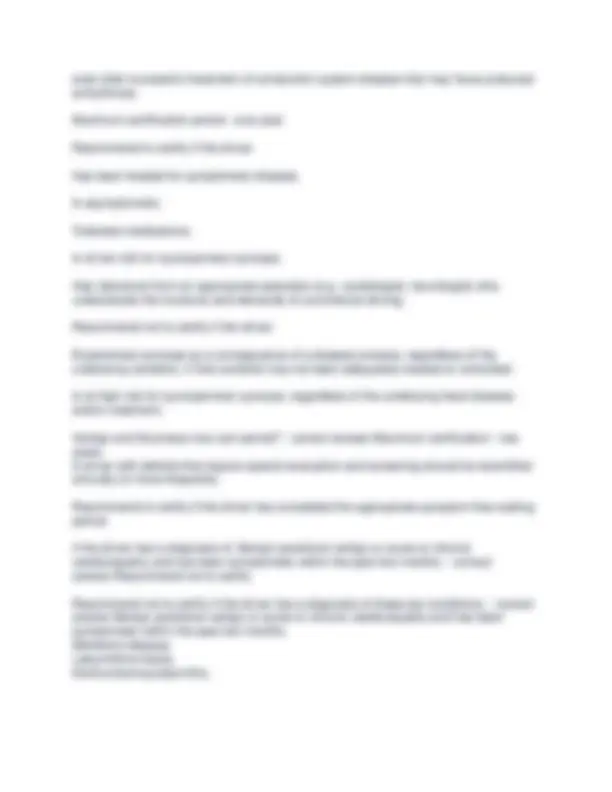
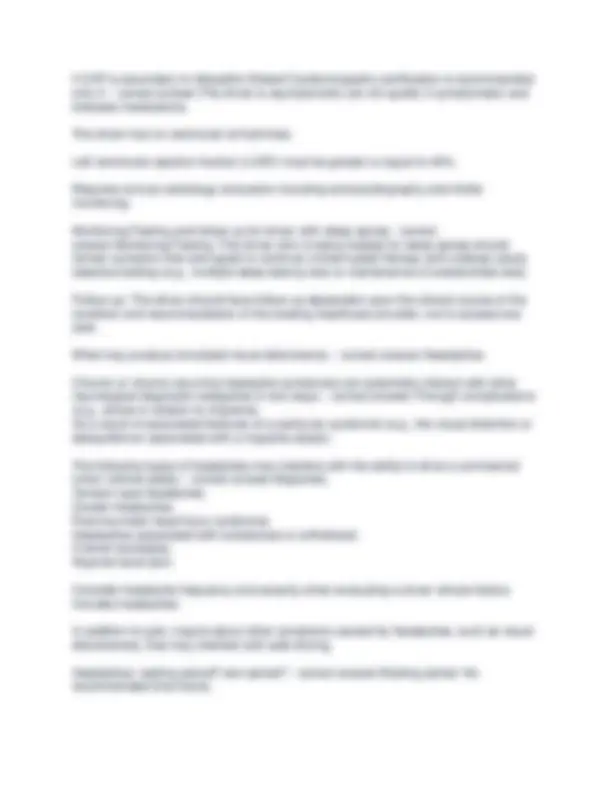
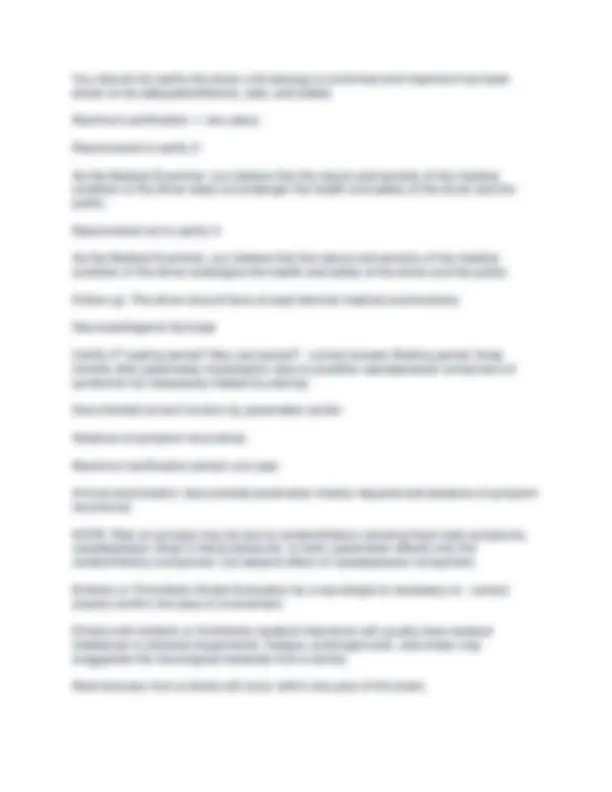
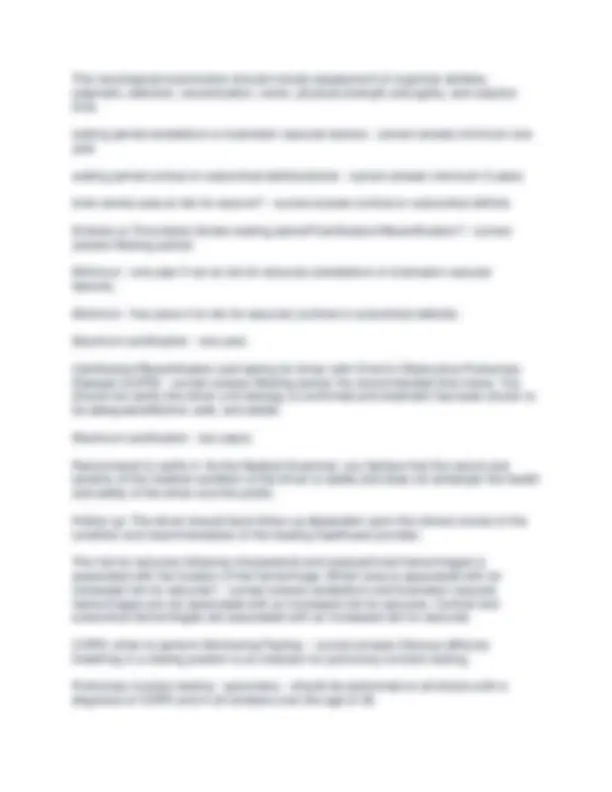
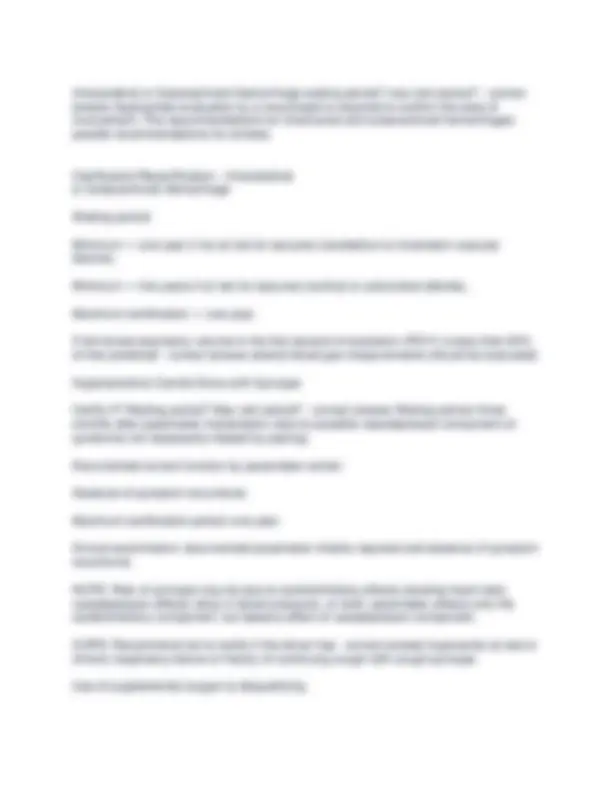
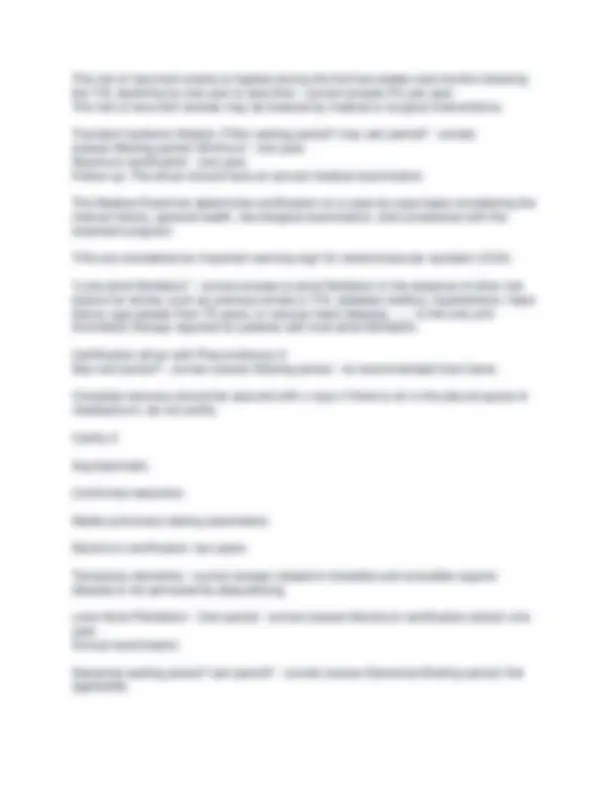
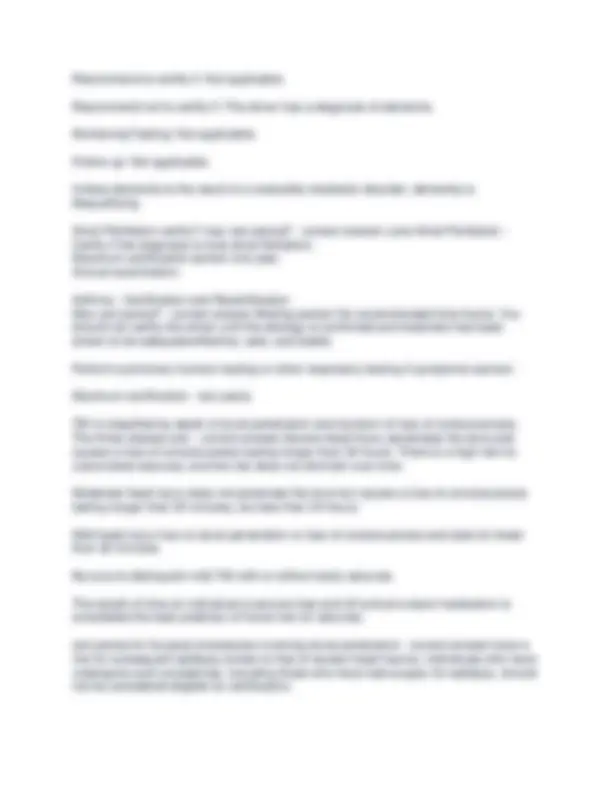
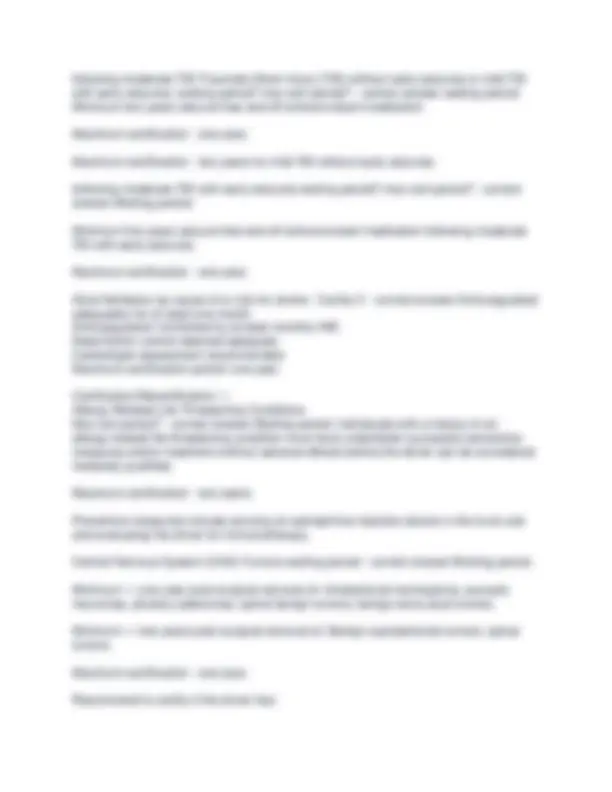
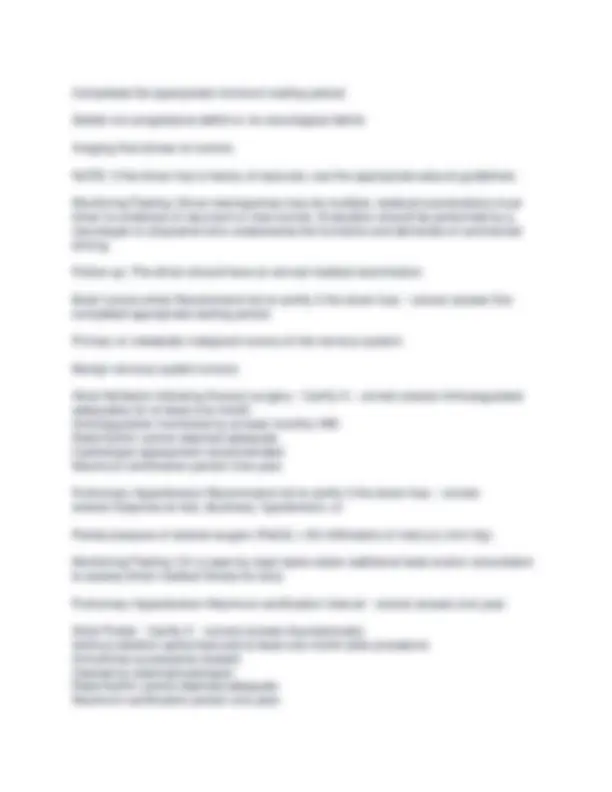
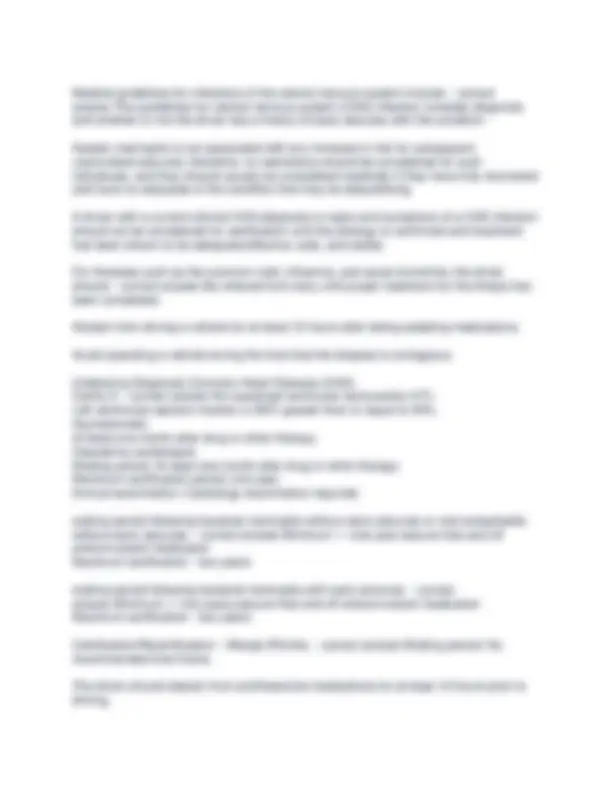
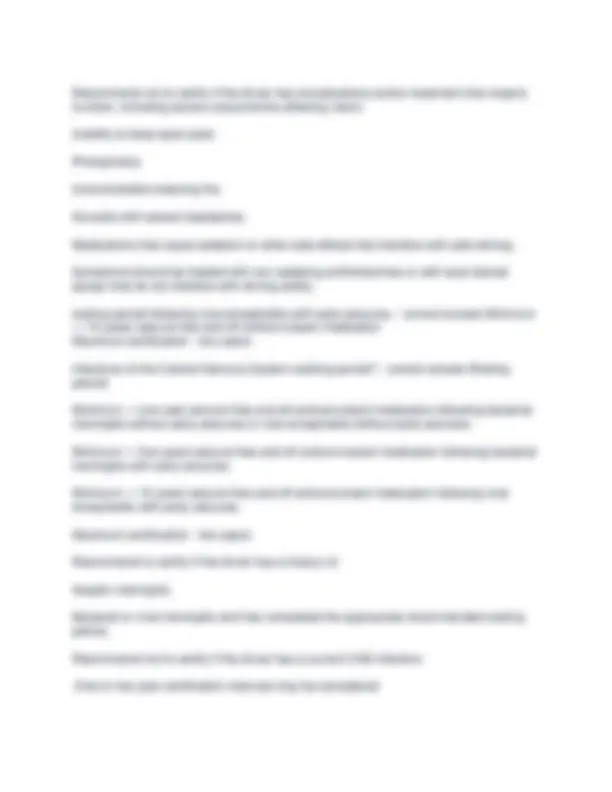
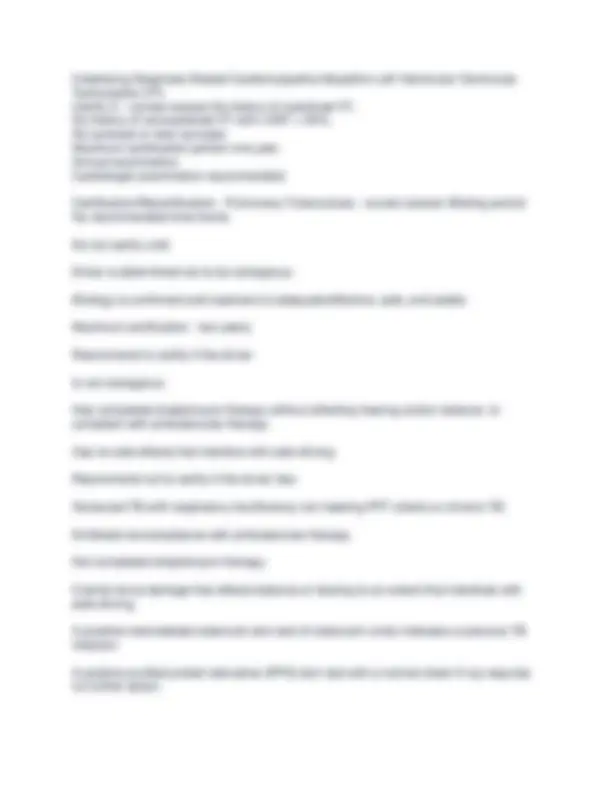
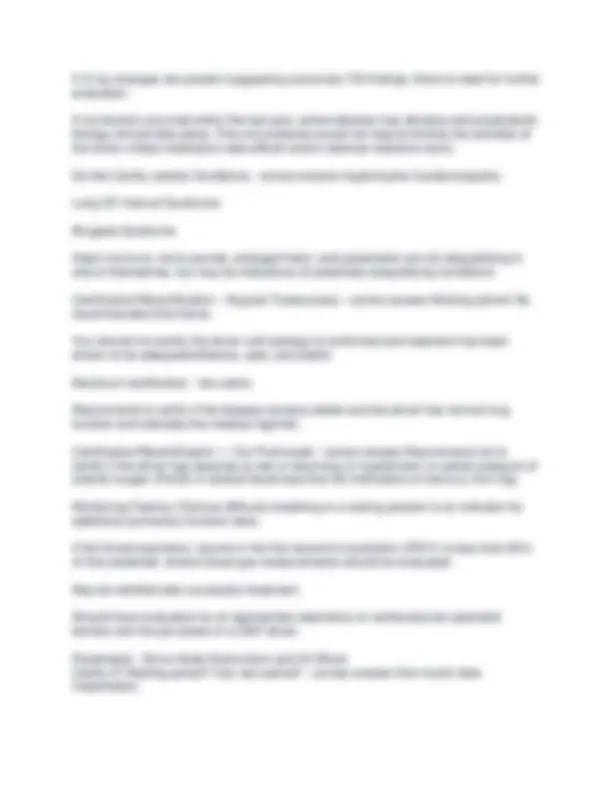
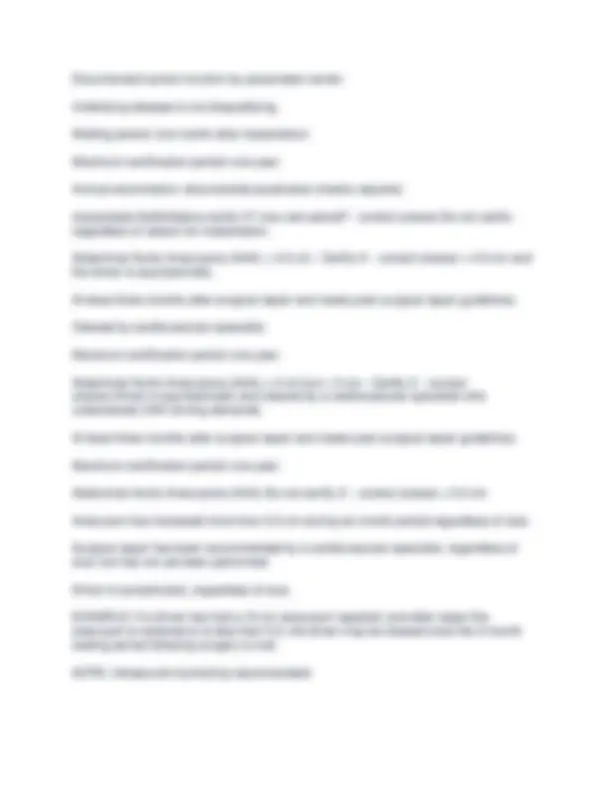
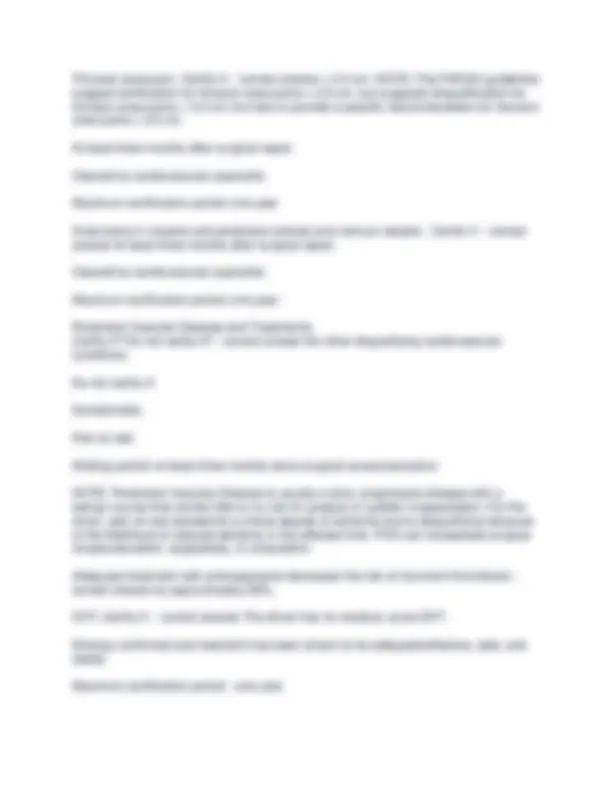
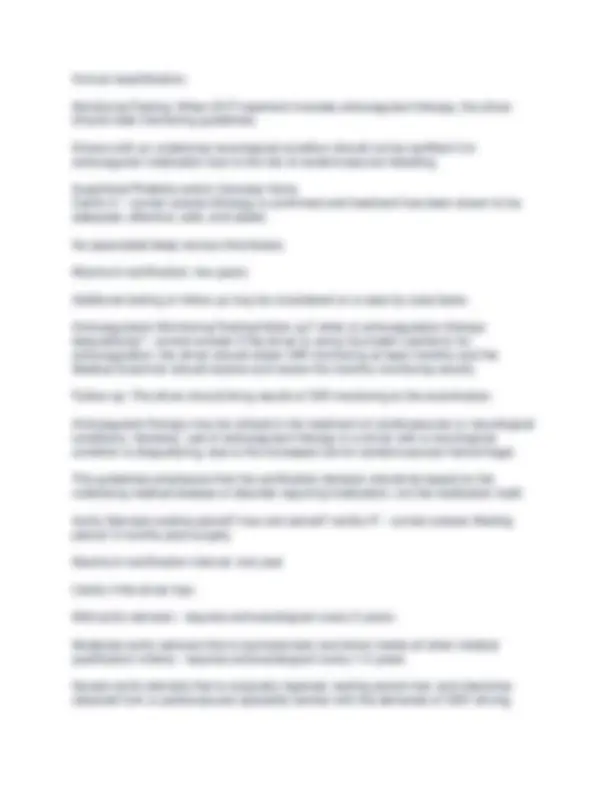
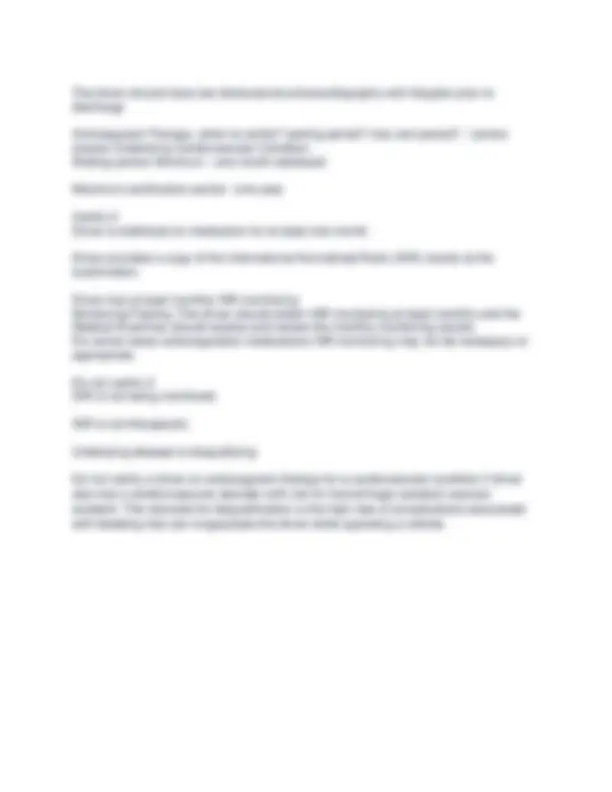


Study with the several resources on Docsity

Earn points by helping other students or get them with a premium plan


Prepare for your exams
Study with the several resources on Docsity

Earn points to download
Earn points by helping other students or get them with a premium plan
Community
Ask the community for help and clear up your study doubts
Discover the best universities in your country according to Docsity users
Free resources
Download our free guides on studying techniques, anxiety management strategies, and thesis advice from Docsity tutors
NRCME Exam With Correct Questions And Answers 2024.
Typology: Exams
1 / 84

This page cannot be seen from the preview
Don't miss anything!













































































Corrective lenses that are prohibited by the FMCSA, including: - correct answer.lenses that correct distance vision in one eye and near vision in the other. telescopic lenses Medical guidelines for the driver with diabetes mellitus include: - correct answer.Annual medical examination. Annual ophthalmologist or optometrist eye evaluation. Disqualification for a diagnosis of unstable proliferative retinopathy. Monocular Vision - correct answer.Monocular vision is disqualifying. However, the driver who has monocular vision that with the better eye meets all vision qualification requirements may be considered for a Federal Vision Exemption if the Medical Examiner finds the driver otherwise medically fit for duty. Monocular vision is defined as vision that is at least 20/40 for distance in one eye with or without correction and vision that is less than 20/40 for distance in one eye with or without correction. The driver must meet other vision requirements in each eye, including visual fields (horizontal field of vision). Federal Vision Exemption: the driver with monocular vision who is applying for or has a federal exemption or is qualified by operation of 49 CFR 391.64 must have an annual physical examination. Drivers with vision loss who meet standards may be certified for up to two years. A driver who wears contact lenses which correct farsightedness in one eye and nearsightedness in the other, but has no other visual impairments can be certified under what additional conditions? Only if the driver wears prescription glasses which provide the same correction as the contact lenses. FMCSA guidance indicates that a driver should not be certified under these circumstances. Only by federal exemption. The driver is always certifiable under these conditions. - correct answer.FMCSA guidance indicates that a driver should not be certified under these circumstances.
Explanation: FMCSA guidance indicates that contact lenses that correct one eye for distance and one eye for near vision are not acceptable. Guidance recommends not to certify with ear problem diagnoses of: - correct answer.a) Uncontrolled vertigo. b) Ménière's disease. c) Nonfunctioning labyrinth. d) Nonfunctioning fistula. The medical examiner's role in the exemption process includes _________. Issuing the exemption. Issuing the prescription for the driver's contact lenses and/or glasses. Providing the driver with contact information for the Federal Vision Exemption Program. Assuring that the driver has peripheral vision of at least 110 degrees in each eye. - correct answer.Providing the driver with contact information for the Federal Vision Exemption Program. Explanation: The medical examiner's role in the exemption process is limited to performing the driver examination and providing the driver with contact information for the FMCSA related to the exemption process. An audiometric test produces the following results: Left ear: 500 Hz, 35dB Loss; 1, Hz, 35 dB loss; 2,000 Hz 45 dB loss. Right ear: 500 Hz, 40 dB loss; 1,000 Hz, 45 dB loss; 2,000 40 dB loss. What is the certification? Certify for one year. Certify for two years. Do not certify. Certify only when accompanied by hearing aid. - correct answer.Certify for two years. Explanation: Drivers with an average hearing loss of < 40 decibels averaged across 500, 1000, and 2000 Hz in the better ear may be certified for two years. What eye conditions must the medical examiner ask the driver about? Cataracts, color deficiencies, retinitis pigmentosa, aphakia, glaucoma. Lazy eye, cataracts, aphakia, floaters, retinopathy. Glaucoma, macular degeneration, retinitis pigmentosa, color deficiencies. Retinopathy, cataracts, aphakia, glaucoma, macular degeneration. - correct answer.Retinopathy, cataracts, aphakia, glaucoma, macular degeneration.
Testing of the driver's hearing may be performed at 1,000 Hz only. - correct answer.Testing of the driver's hearing is waived if the driver presents a letter from a qualified specialist. Testing the hearing of a driver who wears a hearing aid may be accomplished in three ways: 1) whisper test, 2) audiometric testing by an otolaryngologist using specialized audiometric testing equipment, or 3) audiometric testing by an audiologist using specialized audiometric testing equipment. Audiometric testing is required to be conducted at 500 Hz, 1000 Hz, and 2000 Hz. Passing Requirements for Vision Tests - correct answer.Corrective lenses, eye glasses and/or contact lenses may be used. Distance binocular acuity of at least 20/40 (Snellen) in each eye with or without corrective lenses. Field of vision of at least 70º in the horizontal meridian in each eye. Monocular vision - vision meeting requirements in only one eye - is disqualifying by regulation. The ability to recognize the colors of traffic signals and devices showing standard red, green, and amber. Contact lenses that correct vision in one eye for distance and the other eye for near are not acceptable. Results must be converted to Snellen values if another test is used. Measured in each eye individually and both eyes. Drivers who wear corrective lenses should be advised to carry spare glasses. In general, any vision condition, such as lazy eye, glaucoma, cataract, and others, is not disqualifying as long as the driver meets minimum vision testing parameters. FMCSA is - correct answer.Federal Motor Carrier Safety Administration. Is overseen by the DOT. The FMCSA creates standards for driver examinations. Regulates Interstate commercial operations, including the driver. Many states use federal FMCSA standards to govern intrastate commercial operations, including the driver, but the FMCSA does not directly regulate any intrastate functions. a division of the US Department of Transportation (DOT). Conditions which are usually disqualifying, but for which qualification can be considered on a case-by-case basis include __________. Autonomic neuropathy. Methadone use. Monocular vision. Carpal tunnel syndrome. - correct answer.Correct Answer: Autonomic neuropathy. Explanation: Methadone use and monocular vision are always disqualifying. Carpal tunnel syndrome is not usually disqualifying.
A driver experienced a pneumothorax four weeks ago. The medical examiner tests the driver's respiratory function and the forced vital capacity (FVC) is 58% of predicted. What should the certification decision be? Do not certify pending additional testing. Certify for three months, pending driver follow up with personal physician and/or specialist. Certify one year. Certify two years. - correct answer.Correct Answer: Do not certify pending additional testing. Explanation: The driver may not be certified until FVC is > 60% predicted or additional testing reveals acceptable respiratory parameters - e.g., pulse oximetry with O2 > 92%. Stage 1 Hypertension Two certification options: - correct answer.One Year: recommend to certify for one year if it is the first examination at which the driver has blood pressure equivalent to Stage 1 hypertension, and the driver has no history of hypertension and does not use medication for blood pressure control. Three Months: recommend to certify for a three month certification if the driver has been given a one-year certificate for untreated Stage 1 hypertension in the past, whether or not the driver is taking medication to lower blood pressure. If the driver is on blood pressure medication, the medication should be well-tolerated with no side effects that could affect safe driving. Do not certify the driver with Stage 1 hypertension if the driver has been given a three- month certificate related to blood pressure within the past three months. Do not certify a driver with Stage 1 hypertension who has a history of Stage 3 hypertension (> 180/110). The driver with Stage 1 hypertension is at low risk for hypertension-related acute incapacitation. Recertification: Recertification examinations should be done annually thereafter, and driver BP should be at or below 140/90. If at recertification examination the driver with a history of Stage 1 hypertension has a BP greater than 140/90 but less than 180/110, certification may be extended for three months. The Medical Examiner should advise the driver:
One year, one year. - correct answer.One year, six months. Explanation: Following heart transplant, the waiting period is one year and the maximum certification interval is six months. Which of the following is a requirement for drivers with insulin-treated diabetes mellitus (ITDM) evaluated according to 49 CFR Part 391.46? Possess a rapidly absorbable form of glucose while driving. Maintain a hemoglobin A1c value less than 7. Submit blood glucose monitoring records with each certification examination. Check blood glucose 1 hour prior to driving and at least every 2 hours while driving. - correct answer.Correct Answer: Submit blood glucose monitoring logs for each annual certification. Explanation: Drivers with ITDM (insulin-treated diabetes mellitus) must submit at least 3 months of blood glucose monitoring records as part of the annual examination process described in 49 CFR Part 391.46. Although the other practices may represent best practice guidelines, none are required as part of 49 CFR Part 391.46. A driver with a history of bacterial meningitis with early seizures or a single unprovoked seizure requires a waiting period of __________ seizure free and off anticonvulsant medications. One year. Two years. Five years. Ten years. - correct answer.Correct Answer: Five years. Explanation: The waiting period for a history of bacterial meningitis with early seizures or single unprovoked seizure is five years seizure free and off anticonvulsant medications. To apply for an exemption - correct answer.the driver with monocular vision must demonstrate that he or she meets all other medical certification requirements, and must submit the Medical Examination Report and the Medical Examiner's certificate with the exemption application to the FMCSA. NRCME - correct answer.Created by the Federal Motor Carrier Safety Administration (FMCSA), The NRCME establishes a registry of health care providers who may perform medical examinations on commercial motor vehicle (CMV) drivers (DOT examinations). National Registry of Certified Medical Examiners (NRCME) Which of the following is a disqualifying condition?
A past clinical diagnosis of alcoholism. A breath alcohol result of 0.019%. An alcohol-related stable physical condition. Use of methadone. - correct answer.Correct Answer: Use of methadone. Explanation: A current diagnosis of alcoholism is disqualifying, a past history is not. A breath alcohol result of 0.02% or higher renders the driver unqualified to drive. Just because a condition is alcohol-related does not make it disqualifying. Which of the following is true with respect to bipolar disorder? Treatment with lithium has not been shown to increase risk for CMV accidents. The maximum certification interval is six months. The driver should be advised to report manic or severe depressive episodes within 10 days of onset to the driver's employer, medical examiner, or appropriate health professional and to seek medical intervention. Onset of manic episodes is uniformly sudden. - correct answer.Correct Answer: Treatment with lithium has not been shown to increase risk for CMV accidents. Explanation: Treatment with lithium has not been shown to increase CMV driving risk. The maximum certification interval for a driver with bipolar disorder is one year. The driver should be advised to report manic or depressive episodes within 30 days. Manic episode onset may be gradual or sudden. Stage 1 hypertension blood pressure - correct answer.140-159/90- 99 Drivers with initial Stage 1 hypertension should be advised that the condition will allow one-year certification and may or may not require medication treatment for control of the condition. Code of Federal Regulations (CFR) - correct answer.contains the rules of the federal government, laws that must be followed. By regulation, disqualifying medical conditions are epilepsy, monocular vision, and hearing loss. Which of the following is true? The FMCSA does not consider feasibility or impact in the rule-making process. Only the Medical Review Board can provide advice and opinions on FMCSA rulemaking. FMCSA medical standards and guidelines are subject to public notice and comment rulemaking. The Code of Federal Regulations provide guidance that the medical examiner may or may not follow. - correct answer.FMCSA medical standards and guidelines are subject to public notice and comment rulemaking.
A Skill Performance Evaluation (SPE) certificate pursuant to 49 CFR 391.49 is granted under which of the following conditions? The driver has a fixed deficit of the torso. The driver has progressive deficit of an extremity. The driver has a medical evaluation summary completed by a board qualified or certified physiatrist or orthopedic surgeon. The driver has completed a driving evaluation per FMCSA standards. - correct answer.Correct Answer: The driver has a medical evaluation summary completed by a board qualified or certified physiatrist or orthopedic surgeon. Explanation: A driver with a torso deficit should not be certified. To be considered for a Skill Performance Evaluation (SPE) certificate, the driver must have a fixed, not progressive, deficit of an extremity. A driving evaluation is not required for issuance of a SPE certificate. Transient ischemic attacks (TIA's) are automatically disqualifying for __________. After the minimum waiting period the certification depends on the interval history, general health, neurological examination, and compliance with the treatment program. Three months. Six months. Nine months. One year. - correct answer.Correct Answer: One year. Explanation: The minimum waiting period for transient ischemic attacks (TIA's) is one year. A driver with a history of major depression should be evaluated at least every __________ by an appropriate mental health specialist, such as a psychiatrist or psychologist, who understands the functions and demands of commercial motor vehicle driving. Six months. One year. Two years. Such evaluation is not required. - correct answer.Correct Answer: Two years. Explanation: The maximum certification interval for a driver with a history of major depression is one year. Regulatory guidance requires evaluation every two years by a specialist, such as psychiatrist or psychologist, who understands the functions and demands of commercial driving. Passing parameters for hearing tests: - correct answer.Driver first perceives a forced, whispered voice in the better ear at not less than five (5) feet with or without the use of a hearing aid.
Driver, if tested by use of an audiometric device, does not have an average hearing loss in the better ear greater than 40 decibels at 500 Hz, 1,000 Hz, and 2,000 Hz, with or without a hearing aid. The driver meets the hearing qualification requirements if hearing passes one test in one ear. Hearing aid: When a hearing aid is to be worn during audiometric testing, an audiologist or hearing aid center should perform the test using appropriate audiometric equipment. Stage 2 hypertension blood pressure - correct answer.160-179/100- 109 Drivers with Stage 2 hypertension should be advised that a limited certification interval of three months will be provided and that medication treatment is indicated and must be initiated prior to reconsideration of certification beyond the three-month interval. Which of the following is considered by the FMCSA as a mental health professional that the medical examiner may refer to or consult with? A urine drug screen collector. A FMCSA administrator. Medical review officer (MRO). Any licensed medical provider. - correct answer.Correct Answer: Medical review officer (MRO). Explanation: According to the FMCSA, mental health professionals the medical examiner may consult with include breath alcohol technicians (BATs), designated employer representatives (DERs), medical review officers (MROs), and substance abuse professionals (SAPs). Can you certify a driver who has a known AAA? - correct answer.Yes if : less than 4 cm and asymptomatic,
4 cm but < 5 cm - Certify if: and asymptomatic with a vascular specialist clearance. 5 cm with waiting 3 month post repair and specialist clearance. No if: 4.5 cm and symptomatic with surgery recommendations 5 cm with the repair and specialist clearance. Recommendation to NOT surgically repair, does NOT mean driver is certified Maximum certification period: one year. Do not certify if: 5.0 cm Aneurysm has increased more than 0.5 cm during six-month period regardless of size.
If the driver fails to lower blood pressure by the expiration date of the one-time, three- month certificate, the driver will be disqualified until blood pressure is equal to or below 140/90 at exam. Stage 2 hypertension is an absolute indication for anti-hypertensive drug therapy. intrastate - correct answer.within a state Stage 3 Hypertension bp - correct answer.BP > 180/ A commercial motor vehicle (CMV) is defined as... - correct answer.* A vehicle with a gross weight over 26,001 lbs
What is the recommended certification interval for a driver with diabetes mellitus who does not use insulin? Three months. Six months. One year. Two years. - correct answer.Correct Answer: One year. Explanation: Drivers with non-insulin dependent diabetes should be certified for a maximum of one year. A driver with peripheral neuropathy __________. May be certified for one year. Should not be certified by regulation. Should not be certified by guidance. May be certified for three months pending specialist evaluation. - correct answer.Correct Answer: Should not be certified by guidance. Explanation: Peripheral neuropathy is a disqualifying condition. However, this is a guidance recommendation, not a regulatory requirement, so Medical Examiners may consider qualification for a driver with peripheral neuropathy. The maximum certification interval for a driver diagnosed with asthma is __________. Three months. Six months. One year. Two years. - correct answer.Correct Answer: Two years. Explanation: The maximum certification interval for asthma is two years. A driver underwent surgical repair of a 6 cm abdominal aortic aneurysm three months ago. The driver may be certified for __________. Three months. One year. Two years. The driver should be medically disqualified. - correct answer.One year. Explanation: The minimum waiting period for surgical repair of an abdominal aneurysm is three months. The maximum certification interval is one year. disqualifying ear conditions and waiting periods - correct answer.Drivers with conditions affecting the inner ear and balance should not be certified. The minimum symptom free waiting period for drivers with dizziness or vertigo is two months.
Oversee the Department of Transportation. Regulation of intrastate commercial motor vehicle operations. Conduct and oversee the agency's medical exemption and certificate programs. Provide commercial motor vehicle driver examinations. - correct answer.Conduct and oversee the agency's medical exemption and certificate programs. Explanation: The FMCSA is overseen by the DOT, not vice versa. The FMCSA does not oversee intrastate commercial motor vehicle operations. The FMCSA creates standards for driver examinations, but is not responsible to provide examinations. FMCSA responsibilities: Oversee the national medical certification process for CMV drivers who operate in interstate commerce. Develop and implement medical regulations, policies, and procedures. Oversee and support the Medical Review Board in accordance with the Federal Advisory Committee Act. Develop and implement the national registry program - a national Medical Examiner system and a linked national driver medical reporting system. Conduct and oversee the agency. Oversees medical exemption and certificate programs. Serve as the lead federal agency for the regulation of CMV driver health and safety and conduct relevant medical research. The maximum certification interval for a driver with a history of drug abuse or alcoholism is __________. Six months. One year. Two years. Do not certify. - correct answer.Correct Answer: Two years. Explanation: Drivers with a history of drug or alcoholism may be certified for up to two years. Drivers may be subject to drug and/or alcohol testing more frequently, but such testing is performed under 49 CFR Part 40 drug and alcohol testing regulations, not under 49 CFR Part 391.41 driver qualification standards. Spirometry testing should be performed on drivers who smoke and who are over __________ years of age. 30 35 40 45 - correct answer.Correct Answer: 35 Explanation: Spirometry is required for smokers over 35 years of age.
A driver with congestive heart failure (CHF) recently had an echocardiogram demonstrating an ejection fraction of 44%. The driver may be certified for __________ if the driver meets all other qualifications for CHF. One year. Two years. Six months. The driver should not be certified. - correct answer.One year. Explanation: The minimum left ventricular ejection fraction (LVEF) for certification with any cardiovascular condition is 40%. The maximum certification interval for drivers with CHF is one year. documentation requirement with schizophrenia - correct answer.for a driver with progressive schizophrenia cannot be certified, document: Medical Examiner observations and examination. Medical Examiner rationale not to certify. Which of the following is true regarding why regulation is needed to protect public safety? There is little environmental risk from crashes involving hazardous materials. There is greater risk of injury and fatalities to individuals in smaller vehicles from crashes involving commercial motor vehicles. The economic cost of crashes involving commercial vehicles is relatively low. Commercial vehicles do not carry members of the public. - correct answer.There is greater risk of injury and fatalities to individuals in smaller vehicles from crashes involving commercial motor vehicles. Explanation: There is significant environmental risk from crashes involving hazardous materials. The economic cost of CMV crashes is very high compared with crashed involving personal and private vehicles. Some CMV's do carry members of the public. Levodopa/carbidopa may cause the driver to be disqualified because it is used for the treatment of what condition? Parkinson's disease. Peripheral neuropathy. Isaac's disease or Stiff Man Syndrome. Epilepsy. - correct answer.Correct Answer: Parkinson's disease.
compliance with FMCSA drug and alcohol testing rules, the Medical Examiner must be sure to advise the driver of this circumstance - that the testing is being performed based on the Medical Examiner's assessment, not on the basis of FMCSA regulation. A driver with an impairment of an arm, leg, hand, or foot who is otherwise medically qualified, may be certified if the driver does what? - correct answer.gets an SPE certificate. Driver must apply for the SPE certificate from the FMCSA and the FMCSA determines if driver is qualified for the SPE certificate. Driver examination 6/18/2011. Driver disqualified due to benign positional vertigo with last symptoms noted 5/15/2011. Driver advised to return after a __________ symptom free interval for a maximum __________ certification interval. One month, one year. Two month, one year. Two month, two year. Three month, one year. - correct answer.Correct Answer: Two month, two year. Explanation: The waiting period for benign positional vertigo, as well as dizziness and acute or chronic vestibulopathy, is two months symptom free, with a maximum certification interval of two years. Suicide attempt affect on certification - correct answer.loss of certification and create the start of a minimum one-year waiting period for consideration of certification. FMCSA content sources rules and regulations include __________. 49 CFR Part 16 DOT Procedures for Drug and Alcohol Testing. 49 CFR 391.41 Physical Qualifications for Drivers. 49 CFR 391.82 Medical examination; certificate of physical qualification. 49 CFR Part 73: Medical Review Board procedures. - correct answer.49 CFR 391. Physical Qualifications for Drivers. Explanation: Drug and alcohol testing regulations described in 49 CFR Part 40. 49 CFR 391.43 describes medical examiner responsibilities for driver examination. 49 Part CFR Part 391.41 describes physical qualifications for drivers. Medical Review Board procedures are described in internal FMCSA documents. Drivers with Stage 2 hypertension should be advised that: - correct answer.a limited certification interval of three months will be provided and that medication treatment is indicated and must be initiated prior to reconsideration of certification beyond the three- month interval.
also, the risk for gradual or sudden incapacitation is higher with Stage 2 hypertension than with Stage 1 hypertension. Drivers with Stage 1 or Stage 2 hypertension should be advised of the risk that hypertension could progress to Stage 3 hypertension, which would be disqualifying. Which of the following is true? For drivers on Coumadin, INR should be measured every 3 months and records should be provided by the driver to the medical examiner. On exercise tolerance testing (ETT), a driver should exercise to greater than a 10 MET capacity. Left ventricular ejection fraction (LVEF) of at least 40% is required for certification. The waiting period for pacemaker implantation for cardiogenic syncope is two months. - correct answer.Left ventricular ejection fraction (LVEF) of at least 40% is required for certification. Explanation: For patients on warfarin (Coumadin), INR should be checked monthly and records provided to the medical examiner. Exercise tolerance testing (ETT) should be performed to at least 6 METS. The waiting period for pacemaker implantation for cardiogenic syncope is three months. Which of the following is disqualifying? PaCO2 less than 45 mm Hg. PaO2 less than 70 mm Hg at altitudes less than 5000 feet. PaO2 less than 65 mm Hg at altitudes above 5000 feet. PaCO2 greater than 45 mm Hg. - correct answer.Correct Answer: PaCO2 greater than 45 mm Hg. Explanation: PaCO2 of less than 45 mm Hg is not disqualifying, but PaCO2 of greater than 45 mm Hg is disqualifying. An PaO2 saturation of less than 65 mm Hg is disqualifying at altitudes below 5,000 feet and an PaO2 saturation of less than 60 mm Hg is disqualifying at altitudes above 5,000 feet. Drug and Alcohol Testing Who must be tested? - correct answer.All drivers, including part-time drivers, holding a commercial driver's license (CDL) and operating CMVs (greater than 26,000 combined gross vehicle weight rating, or transporting more than 16 passengers, or carrying placarded hazardous materials) on public roadways must be subject to testing according to U.S. Department of Transportation (DOT) drug and alcohol regulations. This means any driver required to possess a CDL, including drivers employed by Federal, State, and local government agencies and owner operators. Equivalently licensed drivers from foreign countries are also subject to these rules.